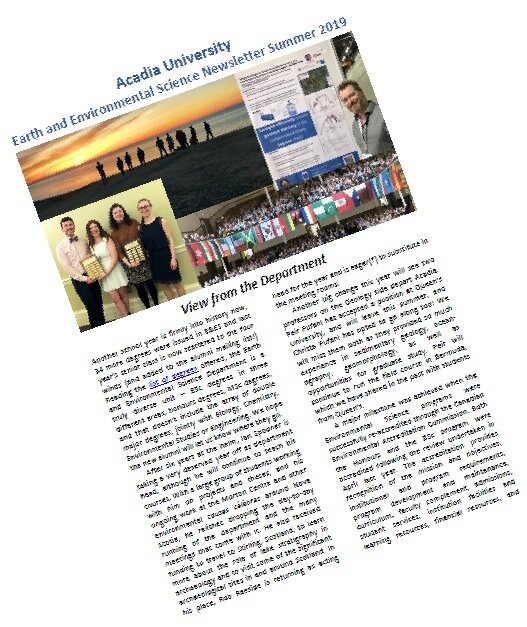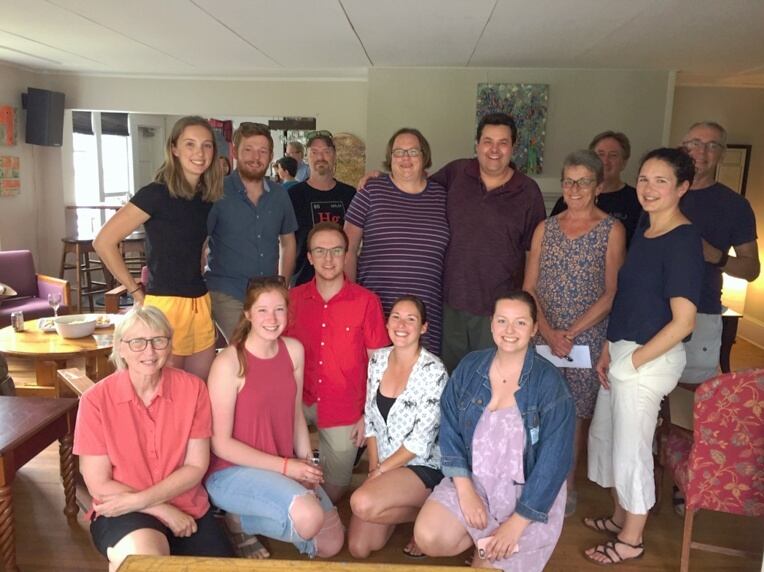Archive of news items - 2019
Clastic Rocks course students present posters
18 December 2019
Students in Dr. Snyder's course, GEOL 3303, Clastic Rocks and Petroleum Geology, made posters for their term paper and presented them in a final lab of the fall term.
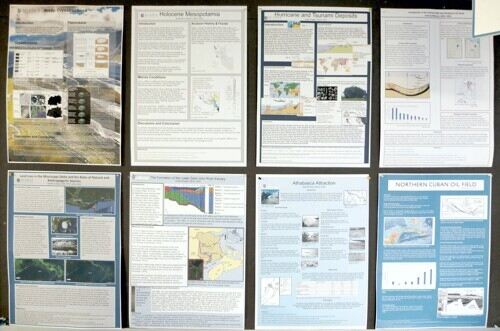 [Click on image for larger version]
[Click on image for larger version]
Included in the topics were Arctic Cryostructure, Holocene Mesopotamia, Hurricane and Tsunami Deposits, a comparison of the Orinoco Belt and the Athabasca Oil Sands, Land Loss in the Mississippi Delta, the Formation of the Lower Saint John River Estuary, the Athabasca Glacier and the Northern Cuban Oil Field.
Dr. O’Driscoll’s research group at SETAC World meeting in Toronto
12 November 2019
The O’Driscoll’s research group (Mercury Lab) attended the Society of Environmental Toxicology and Chemistry (SETAC) World meeting in Toronto this Nov. 3-7.
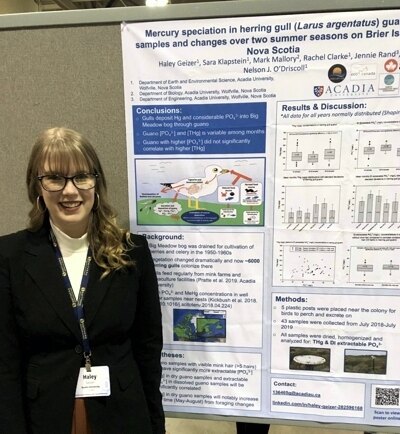
Haley Geizer (BScH) presented a poster examining mercury deposition in gull guano.
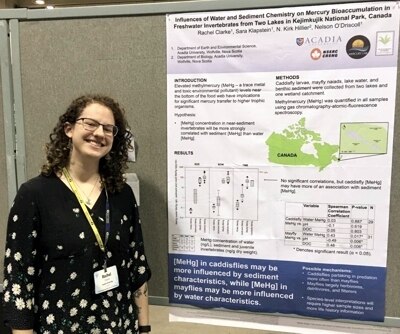
Rachel Clarke (MSc) presented a poster and a talk on mercury bioaccumulation in Kejimkujik and mercury photochemistry in estuaries; Jessie McIntyre (MSc) presented a poster on mercury deposition to soil by birds.
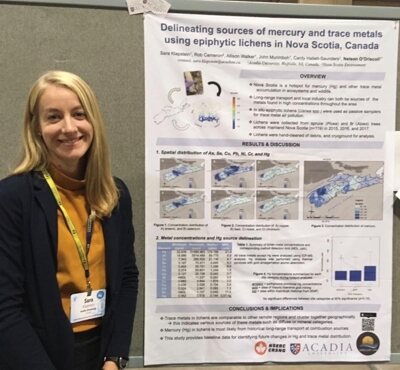
Sara Klapstein (PDF, pictured above) presented her research on mercury speciation with wetland restoration and lichens as biomonitors.
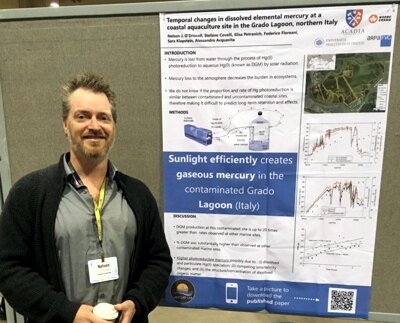
Dr. O’Driscoll presented work on mercury in an Italian Aquaculture site.
Other work was presented on mercury bioaccumulation Patagonia in collaboration with Chilean colleagues in several mercury sessions chaired by Dr. O’Driscoll. Students had many networking events with industry, NGO, and government and were treated to keynote lectures by bestselling author Kate Harris, director of the Mohawk Council of Akwesasne Henry Lickers, and environmental lawyer Dianne Saxe.
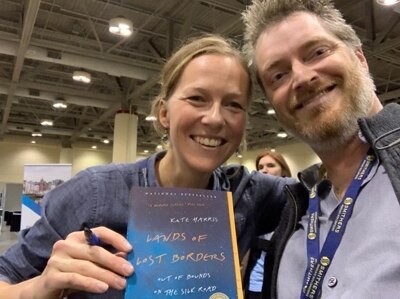
Boundary|Time|Surface
5 November 2019
The Earth and Environmental Science Department and the programs in Art teamed up to host a special cross-disciplinary presentation entitled Boundary|Time|Surface: Art and Geology Meet in Gros Morne National Park, Newfoundland, Canada by artist Sydney Lancaster and geoscientist John Waldron. Normally resident in Edmonton, John is a Harrison McCain visiting professor at Acadia in the fall term. Sydney and John coordinated the installation of an ephemeral sculptural work created to interrogate the brevity of human experience relative to the enormity of time, and the fragile and arbitrary nature of human-defined boundaries. In the presentation, John outlined the significance of the system stratotypes, and Sydney presented an overview of the construction of a fence of driftwood poles erected to mark the Cambrian-Ordovician boundary at Green Point, Newfoundland. A publication arising from the project can be purchased from the Atlantic Geoscience Society.
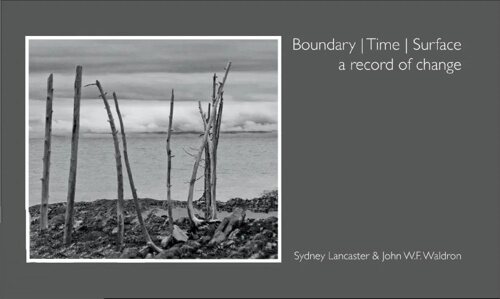
AUGC 2019 at St. F.X.
27 October 2019
Eight students and two professors from Acadia attended the 69th Atlantic Universities Geoscience Conference at St. F.X. University. The conference began on Friday morning, 25 October, with field trips to led by professors from St. F.X. to the Northern Antigonish Highlands or to the Atlantic Gold mine at Moose River, and a short course on the use of the hydrothermal diamond anvil cell for high-pressure and temperature petrological modelling. The CSEG Challenge Bowl was held on Friday night, with teams from St. F.X., Dalhousie and St. Mary's competing. Saturday was devoted to technical presentations with talks and posters running all day.
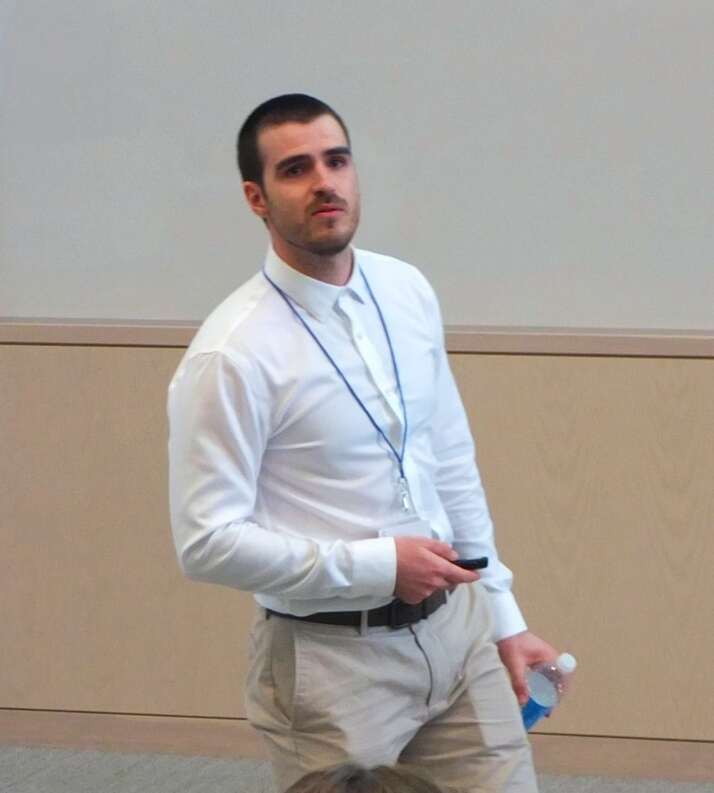
From Acadia, Miguel Vaccaro presented his honours thesis findings on Petrology, age and tectonic setting of the Gunshot Brook pluton, eastern Cobequid Highlands, Nova Scotia.
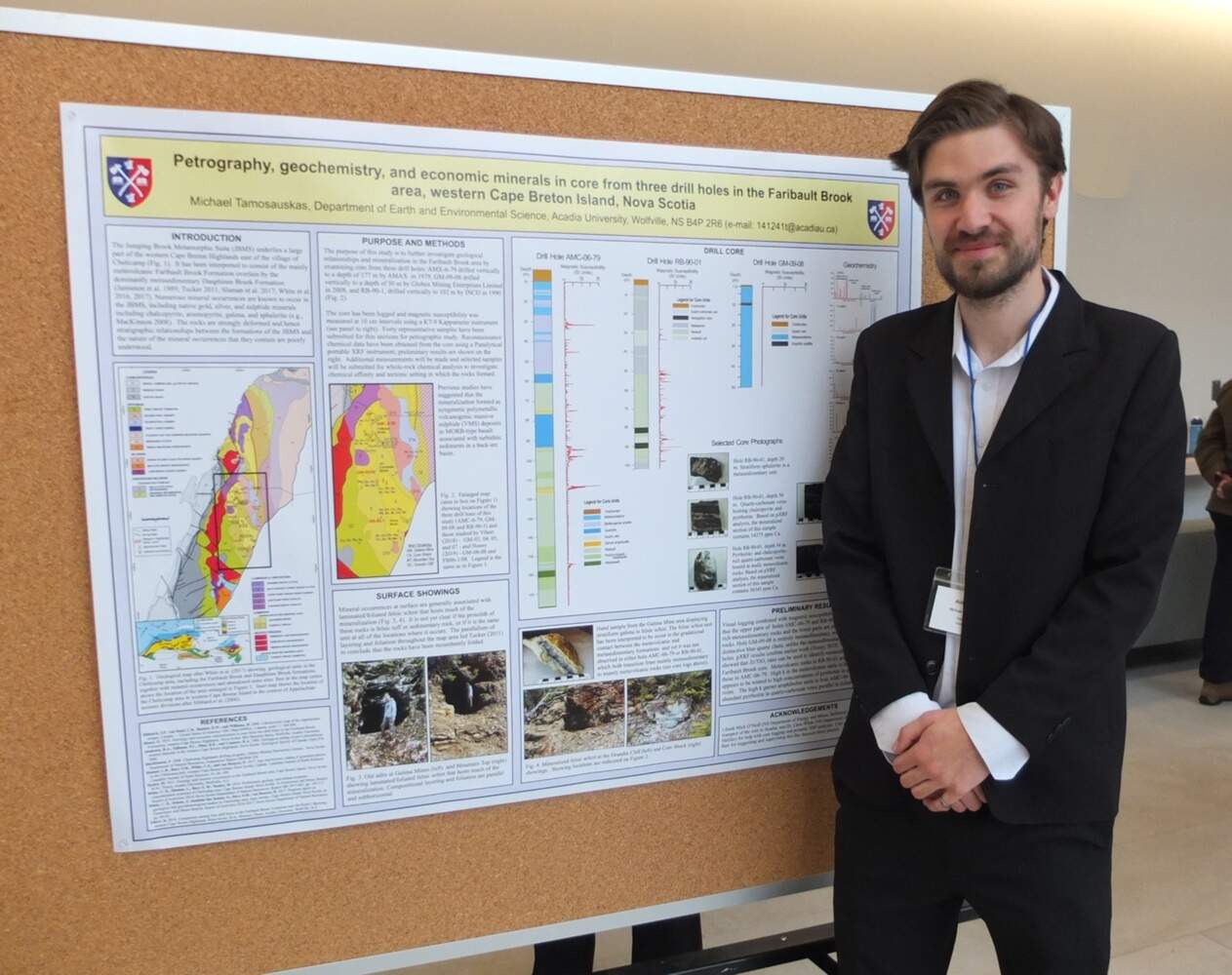
Michael Tamosauskas presented a poster on the Petrography, geochemistry and economic minerals in core from three drill holes in the Faribault Brook area, western Cape Breton Island, Nova Scotia.
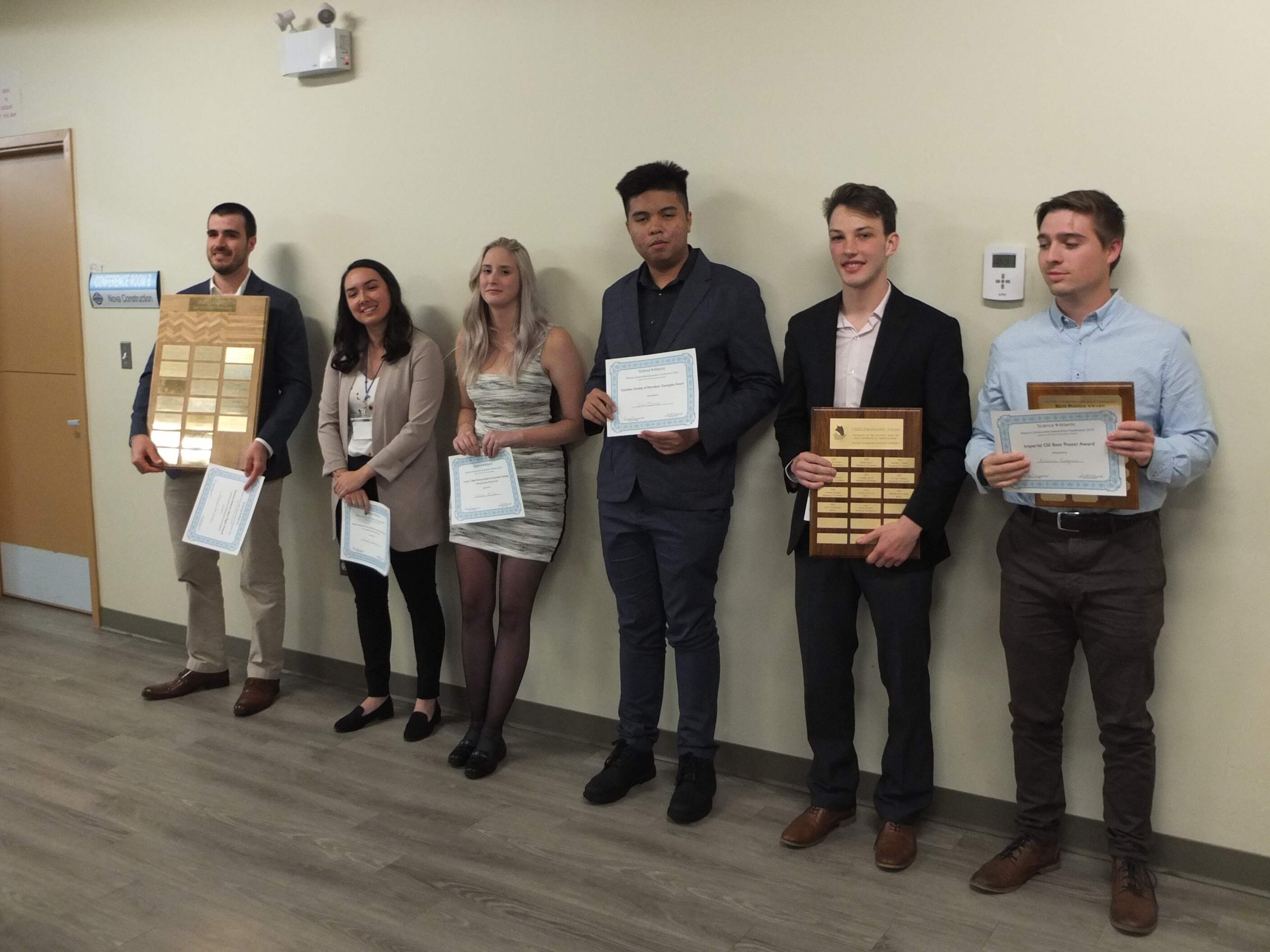
Congratulations to all the prize winners (left to right):
- Miguel Vaccaro (Acadia), winner of the Science Atlantic Best Paper Award
- Kayla Lawrence (MUN), winner of AGS Environmental Geoscience Award
- Natalie McNeil (St. Mary's), winner of the Frank S. Shea Memorial Award in Economic Geology
- John Mishael Dooma (St. Mary's), winner of Canadian Society of Petroleum Geologists Award
- Alex Bugden (MUN), winner of the Canadian Society of Exploration Geophysicists Award
- Andrew Wagner (St. Mary's), winner of the Imperial Oil Best Poster Award
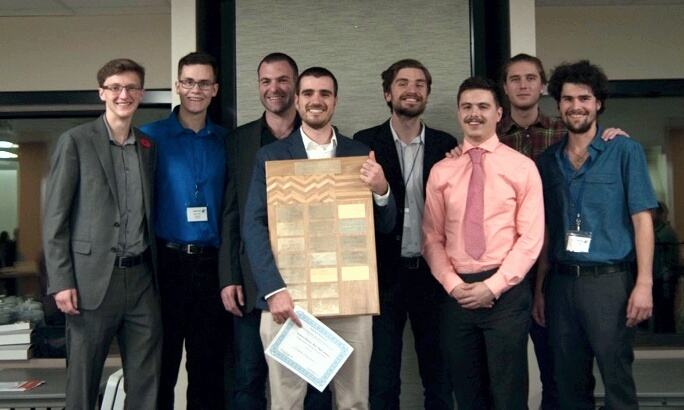
Acadia University student participants: Geoff Sharp, Nathan Carter, Justin Tupper, Miguel Vaccaro, Michael Tamosauskas, Cameron Greaves, Owen Paget, Zach Martin.
Fletcher Club climbs On-Tree
30 September 2019
Students in the Fletcher Geology Club swapped their hammers for ropes on the last Saturday of September as they took on the climbing array at Ontree, Windsor.
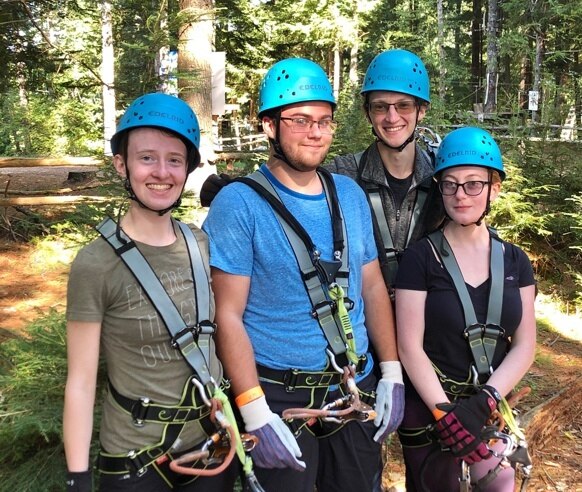
Caryn, Alan, Geoff and Molly are here all harnessed up ready to go.
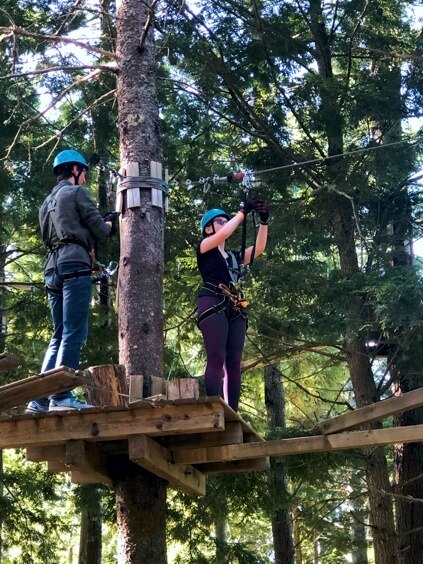
Geoff and Molly high in the trees, enjoying Canada's largest high ropes challenges park!
Photos by Nathan Carter.
Field trip to Rainy Cove
22 September 2019
<figure>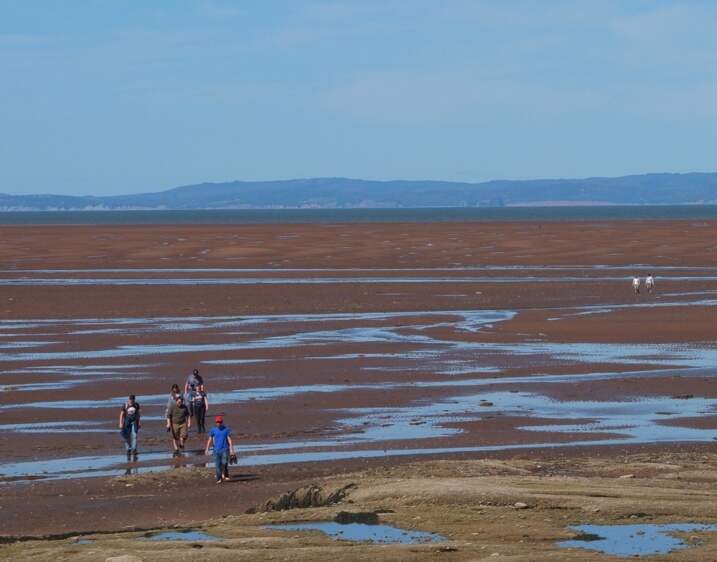 </figure>
</figure>
Dr. Raeside and Dr. Snyder took an eager group of students to examine outcrops along the Noel Shore, Hants County on 21 September. Accompanied by Dr. Ricketts who provided some novel insights into the generation of the coastal geomorphology, the group started at Walton, viewing the spectacular folding of the Horton Bluff Formation.
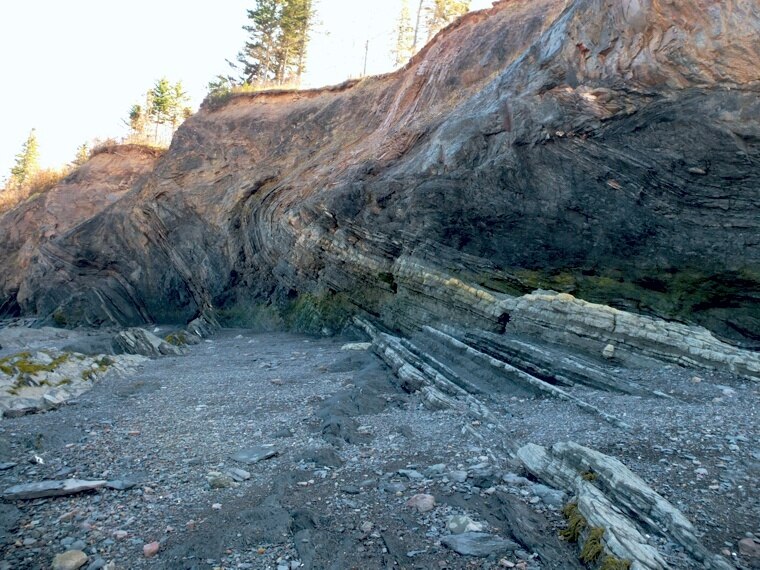
After lunch at the lighthouse, the group headed to Rainy Cove and out on to the sand bars with metre-high dunes. Excavation of a dune reveals the structure of the sediment.
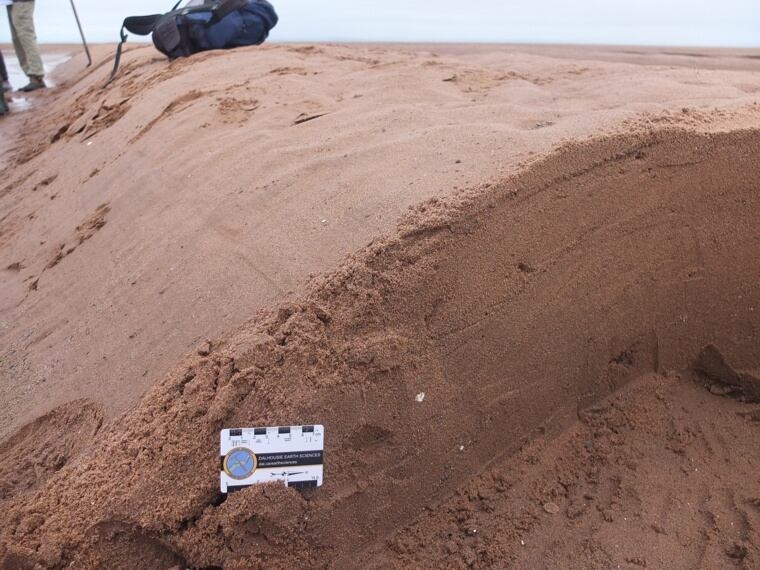
With the tide turning we returned to dry land to examine the sedimentary structure of the Triassic Wolfville Formation, which shows many of the same features as we saw on the modern dunes.

Finally at Rainy Cove, we hunted Carboniferous tree stumps and found a pair of them at the top of the beach.
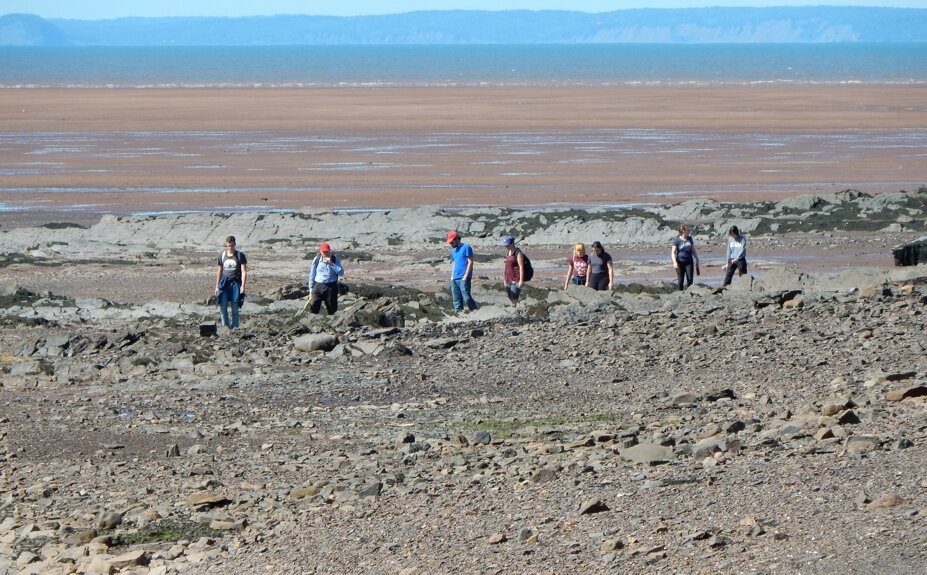
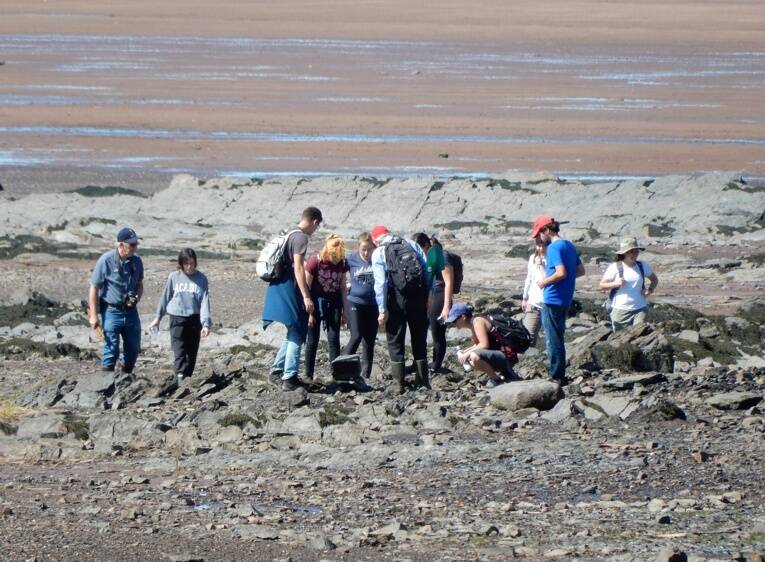
Finishing our tour at Rainy Cove we moved on to Cheverie where we examined several units - the Windsor Group, and the Pembroke, Macumber and Cheverie formations. Here we found sandstone with tree branch fossils, limestone with soft-sediment deformation, brecciated limestone and great pavements of gypsum, much of it oozing petroleum. Some blocks of gypsum show evidence of shearing with S and C fabric enhanced by solution weathering.

At the end of the day, participants were tired, but happy, most with new treasures to adorn their dorm rooms.
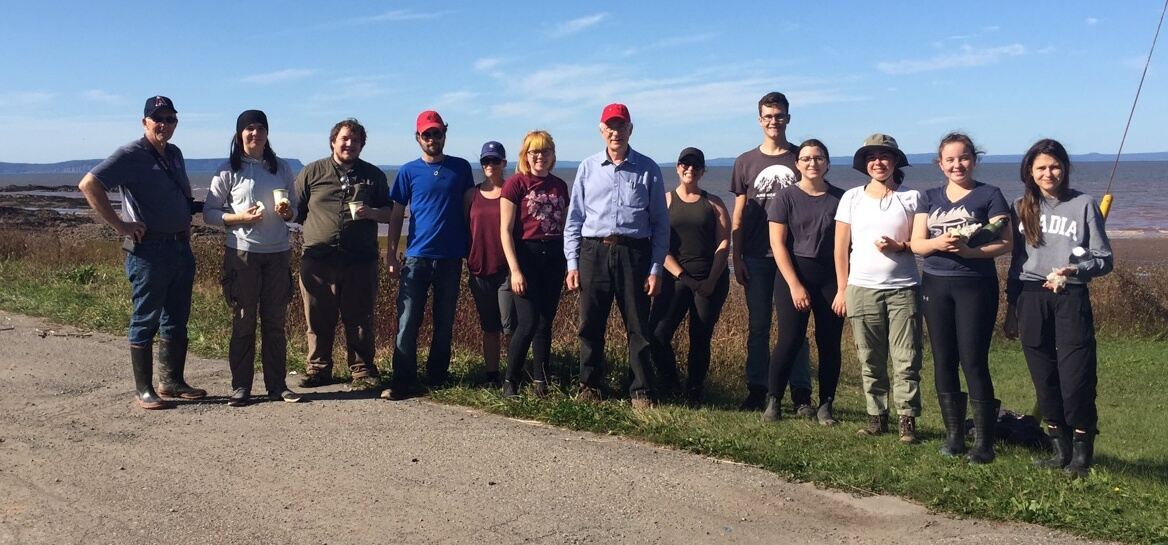 [Photo by Peter Ricketts]
[Photo by Peter Ricketts]
Welcome to two new professors in E&ES
3 September 2019
The Department of Earth and Environmental Science is very pleased to welcome Dr. Morgan Snyder and Prof. Dewey Dunnington to the teaching faculty for the fall term.
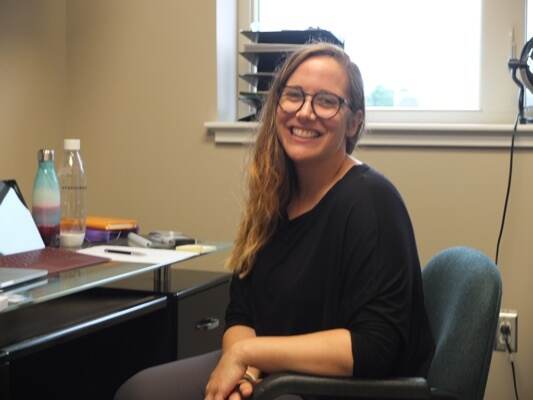
Dr. Snyder recently completed her PhD thesis at the University of Alberta, but has also worked on rocks near Acadia, in Hants County. She studies structural geology and sedimentology and will be teaching GEOL 3303 (Clastic Rocks and Petroleum Geology) in the fall, and Oceanography and History of Life in the winter term.

Dewey Dunnington is working toward his PhD in Environmental Engineering at Dalhousie University and is teaching GEOL 2703, Applied Geomorphology, in the fall term.
Welcome to both new faculty members - we are delighted to have you aboard!
Senior Field School 2019
3 September 2019
The first part of Senior Field School has concluded in Cape Breton Island. Offered by Sandra Barr and Rob Raeside, the students mapped an area in the Cape Breton Highlands and enjoyed lots of waterfalls and mountain views.
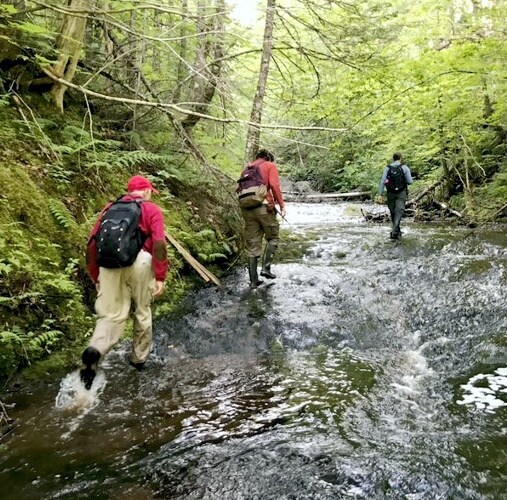
Quarry Brook has some fine trails of moss-lined streams. Easy walking up to the limestone!
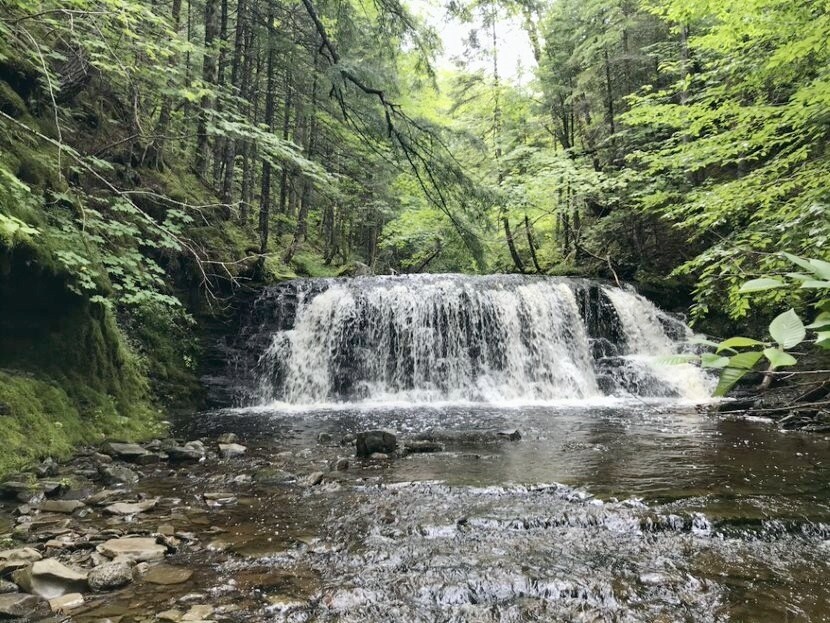
One of the prettier waterfalls in Neil MacLeod Brook.

A fine view from lunch stop on Cape Smoky on the Cabot Trail field trip
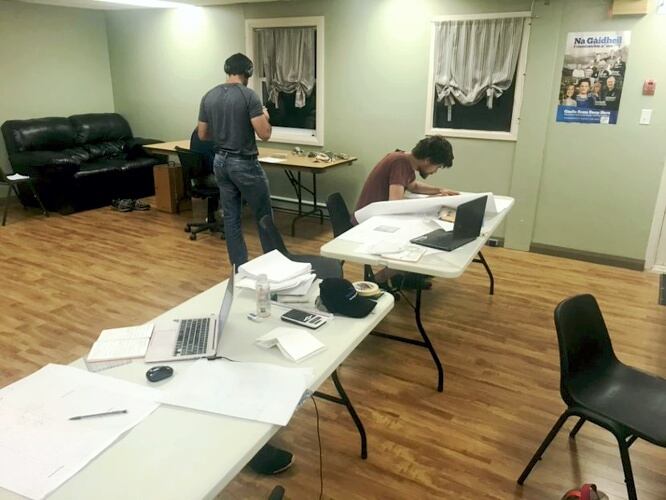
Hard at work, late at night, in MacLeod House at the Gaelic College.
The mystery of the tram line cobblestones in Halifax
21 August 2019
Dr. Sandra Barr was approached by Mick O'Neill, former graduate student at Acadia, now a Nova Scotia Dept of Energy and Mines geologist, to identify the source of the paving stones used for the old Halifax tram lines. Mick had acquired some samples of the stones and needed to identify them for storage. You can see the appearance of these brick-shaped cobblestones in photographs at https://skyrisecities.com/news/2016/06/once-upon-tram-halifax-street-railway. They are pale brown and fine-grained, and were mostly removed when the trams were discontinued in 1949.
We made some thin sections of them:
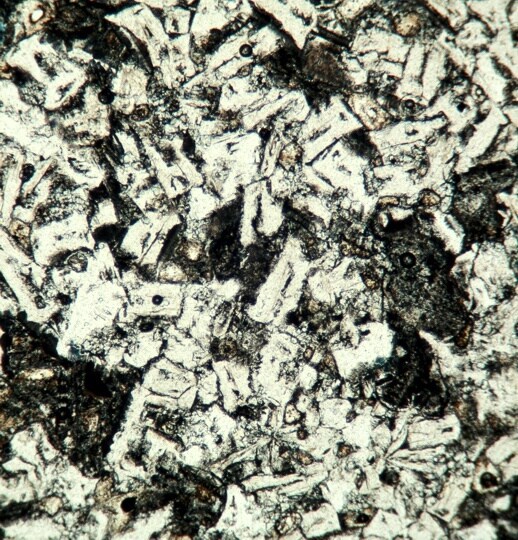 (field of view about 2 mm across)
(field of view about 2 mm across)
In thin section, the rocks are very fine-grained and made of colourless grains with distinctive hollow cores ("belt-buckles") or long tapering corners ("swallow-tails"). Students in igneous petrology will recall those textures are distinctive of plagioclase in quickly cooled sea-floor basalt.
Under crossed polars the belt-buckles show low first-order interference colours, and near extinctions display the distinctive Prussian blue and dark chocolate brown tones of dispersion, again both distinctive features of plagioclase:
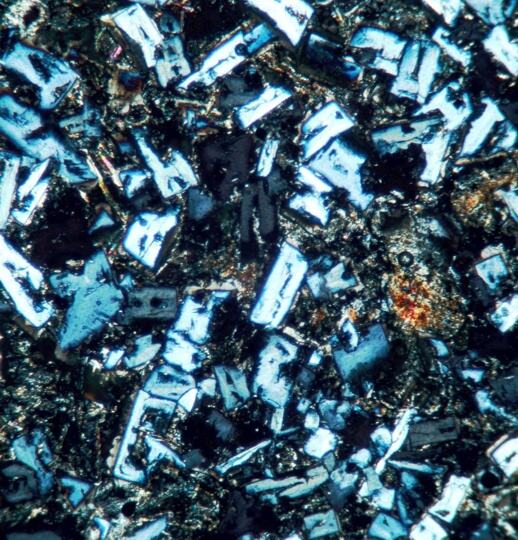
The more brightly coloured minerals are likely pyroxene. Although plagioclase + pyroxene are the minerals that make basalt, it turns out this material was most likely artificial. It's not possible to say if it was specially made for the manufacture of the paving stones, or if it was recycled steel foundry slag. One clue is that during sawing of the rock to make the thin section, it emitted the powerful smell of H2S, a hint that there must be significant sulphur in it too.
Alumni newsletter sent out
26 July 2019
Read about the activities of the Earth and Environmental Science Department and feedback from our alumni. The annual newsletter was completed recently and sent out to 750 alumni email addresses. Click on the image for access to the full text.
Peir and Christa Pufahl depart from Acadia
17 July 2019
Dr. Peir Pufahl is leaving Acadia after 14 years of teaching in the sedimentology-paleontology-oceanography areas of Geology. Peir came to Acadia from a post-doc position at Queen's University, and he is returning to Queen's to take up a senior position in chemical sedimentology and as director of the Queen's Facility for Isotope Research (QFIR) lab. Peir's work has included research on Windsor Group carbonate rocks, ejecta deposits in Ontario and Wisconsin, iron formations in Labrador and Australia, and phosphate deposits in Brazil. We will miss the diversity of research opportunities he has brought to Acadia.
Christa Pufahl also departs with Peir! Christa has been very active in our department also, teaching in geomorphology, paleontology and oceanography, and will also be missed by students in all our programs.
A departing soiree was held in honour of the Pufahls at the University Club. In the middle of summer, many people are away on business or holiday, but a sizeable group managed to gather to fête them on their departure.
Helicopter work in the Cape Breton Highlands
7 July 2019
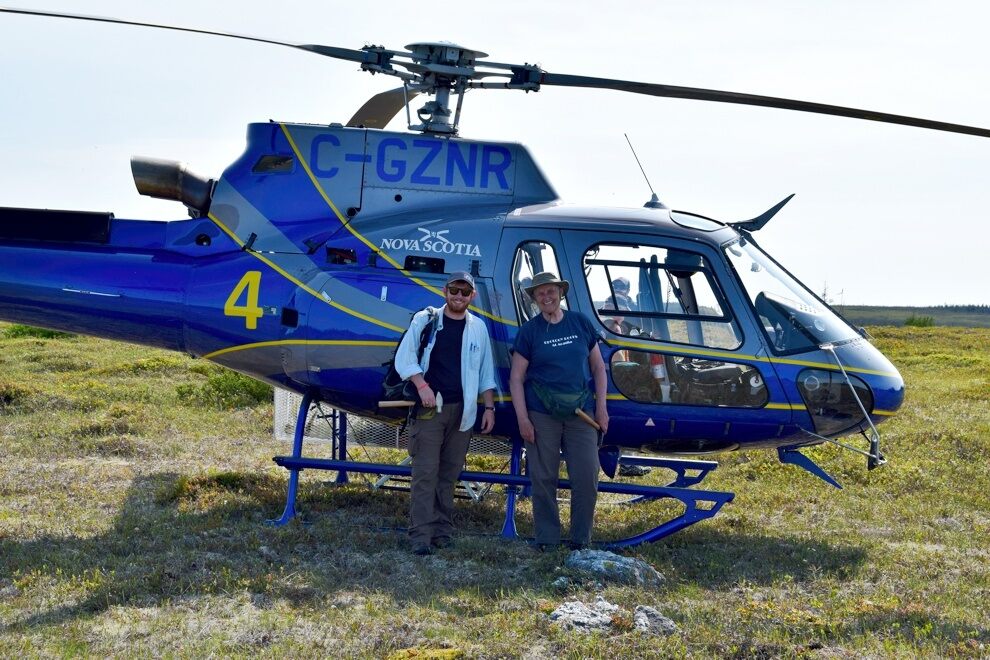
Acadia MSc student Caleb Grant was able to collect rock samples from the most remote parts of his thesis area in the Cape Breton Highlands by helicopter on July 4th. The trip was arranged by adjunct professor Dr. Chris White using a Nova Scotia Department of Energy and Mines helicopter. Caleb's thesis supervisors Sandra Barr and Donnelly Archibald were also on the flight, as well as honours student Miguel Vaccaro. Other than rarely seen rock outcrops at elevations close to 500 m, the group was amazed to see large areas still covered by snow, a testament to the heavy winter snowfall and cold weather during May and June. A few moose were also spotted, and spectacular waterfalls.
The photograph of Caleb, Sandra, and the helicopter was taken by Donnelly Archibald at the top of Big Southwest Brook (46°48'04.2"N 60°32'29.2"W).
Jeff Parks, Acadia Geology graduate, takes office as President of Geoscientists Canada
24 June 2019
As announced by Geoscientists Canada, Acadia grad of 1987, Jeff Parks, assumed the office as President of Geoscientists Canada for 2019-2020, after serving a year as President-Elect. Mr. Parks resides in Lewis Lake, NS, and is a Senior Environmental Geoscientist and GIS Specialist with GHD.
Ian Spooner awarded Faculty of Science Teaching Award
7 June 2019
At the end-of-term Faculty Council meeting Ian Spooner was awarded the Faculty of Science Teaching Award. Awarded annually, the nomination for this award was made by his students and colleagues in recognition of his many years of work in and outside the classroom.
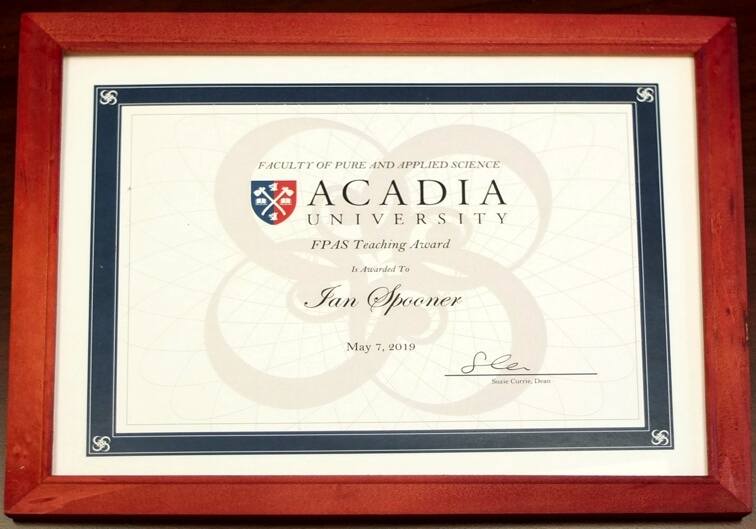
Since coming to Acadia in 1994, Ian has taught 11 different courses at levels ranging from first-year ("Natural Disasters") to senior & graduate ("Quaternary Environments") and in a wide range of areas from Sedimentary Petrology to Environmental Impact Assessment. His classes are engaging and often unpredictable; Ian's ability to weave stories into lessons is one of a kind. The tales of his adventures in the field might even be matched by the adventures students have in his field labs.
As well as teaching a wide range of courses, Ian has supervised 47 honours and 30 masters students in topics ranging from petroleum geoscience to archaeology, with many in the area of environmental change as recorded by deposits in lakes from northern BC to Nova Scotia.
A few extracts from the nominations by his students reveal the nature of Ian's teaching:
"My favourite part of the learning experience I had with Ian was that his lessons were always practical. The “real world” connections that he incorporates into his lessons truly make you feel the importance of what you’re learning."
"To be taught by Dr. Ian Spooner was nothing short of a transformative experience... Oftentimes funny and insightful, Dr. Spooner will tell stories and give examples of the content we are learning. His ability to insert these real-life examples always kept his lessons grounded in reality. He didn’t just leave students with an understanding of certain topics, but a bearing on why it is important, why it is complex and how it impacts other people. It is this broad way if thinking that you take away from Dr. Spooner’s lectures that transforms you as a person."
"Ian had a powerful impact on my career path and my understanding of science, in general. From my experience as his graduate student, it is clear that Ian sees his work extending well beyond papers and research - he sees the value in mentoring and inspiring students to pursue careers in science and to look at science through a holistic approach. Ian's investment in my success and commitment to my growth as a scientist are traits I try to emulate in my own mentoring roles at work."
"During my undergraduate years, Dr. Spooner facilitated an affable and keen teaching atmosphere. What distinguishes Dr. Spooner is his motivation to ensure his students not only receive a top tier education, but also gain the essential academic experience to benefit careers in the post-university life."
"Ian is willing to put in the time and effort to see young people grow as students, athletes and ultimately as humans."
Congratulations, Ian - this award is well-deserved.
Nelson O'Driscoll and students at SETAC, Helsinki
28 May 2019
In May, Dr. Nelson O'Driscoll travelled to Helsinki, Finland, to the annual Society of Environmental Toxicology and Chemistry (SETAC) conference. Nelson presented a poster on "Temporal Changes in Dissolved Elemental Mercury at a Coastal Aquaculture Site in the Grado Lagoon, Northern Italy". Recent graduate, now MSc candidate, Rachel Clarke travelled with him and displayed her poster on "Salinity Influences in Mercury Photochemistry in Estuarine Rivers in the Minas Basin, Nova Scotia". Also present was Sara Klapstein, who has been working with Nelson in a post-doc, investigating sources of mercury from epiphytic lichens in Nova Scotia.
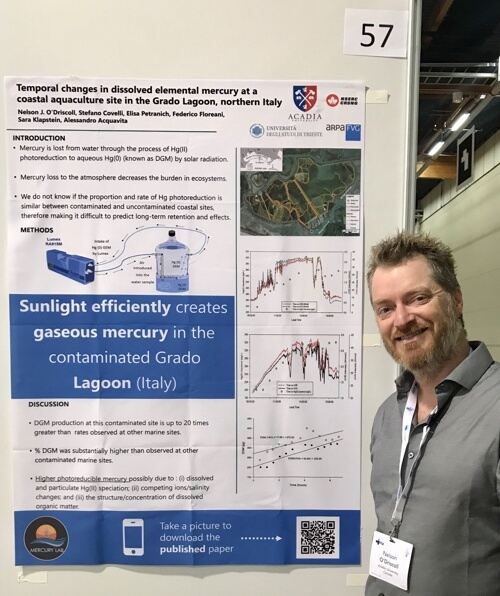
Nelson with the Grado Lagoon poster
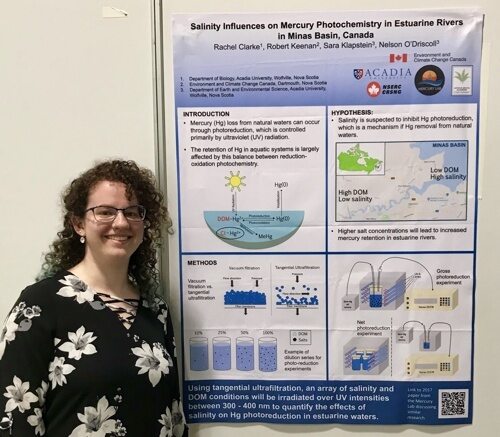
Rachel Clarke at the Helsinki conference
Gabriel Santos wins Léopold Gélinas Silver Medal
22 May 2019
Recent graduate student, Gabriel Santos, was announced as the 2019 Recipient of the Léopold Gélinas Silver Medal. This award is made for the most outstanding thesis, written by Canadians or submitted to Canadian universities, which comprise material at least 50% related to volcanology and igneous petrology. The silver medal is awarded for the best M.Sc. thesis on the basis or originality, validity of concepts, organization and presentation of data, understanding of volcanology & petrology, and depth of research.
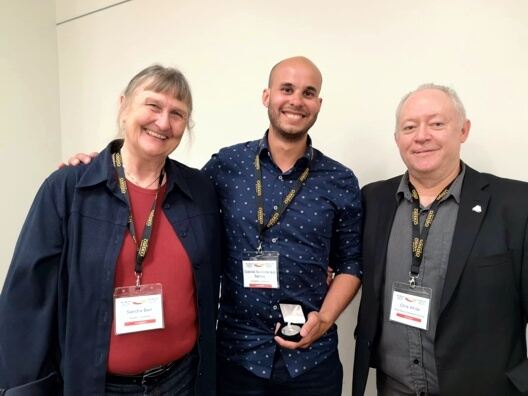
Gabe Santos pictured (centre) with supervisors Sandra Barr and Chris White. His thesis was on "Petrology, age, and regional implications of the Margaree pluton, Aspy terrane, Nova Scotia"
The award was presented to Gabriel during the 2019 annual meeting of the GAC in Quebec City in May. In making the award, the selection committee noted that they were impressed by his "exceptional research". Gabriel is currently pursuing a PhD degree at the University of Waterloo on deformed ophiolitic rocks in China.
South Shore Field Trip 2019
18 May 2019
The annual departmental field trip around the periphery of the Meguma terrane of southern Nova Scotia took place on April 22-23. Acadia students and professor Sandra Barr were joined by Atlantic Gold Corporation geologists (including three Acadia graduates) and Chris White of the NS Department of Energy and Mines.
On Day 1, the group examined metasedimentary rocks of the Goldenville and Halifax groups at low to high metamorphic grades, as well as some of the granitoid plutons and Shelburne gabbroic dyke that intruded them between Dublin Shore and Pubnico. After overnighting in Yarmouth, the second day was spent looking at rocks northwest of the Chebogue Point shear zone, including the Goldenville and Halifax groups and metavolcanic and metasedimentary rocks of the Silurian White Rock Formation. Although rain and fog persisted through both days of the trip, participants remained enthusiastic, noting that many of the rocks look better when wet. We are grateful to Atlantic Gold Corporation for covering many of the costs of the trip.
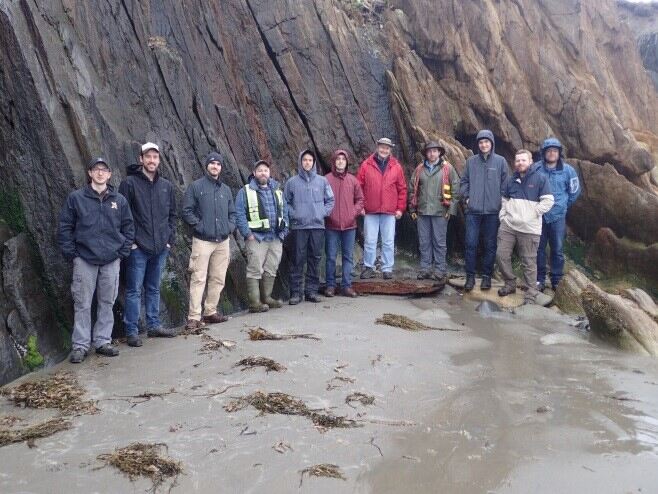
Field trip participants at the contact between dark grey slate of the Bear River Formation of the Halifax Group (left) and pale brown felsic tuff of the White Rock Formation (right) on the beach at Cape St. Mary.
Report from the field - Alex Squires in NWT
16 May 2019
Alex Squires completed her MSc work in the winter and graduated in May. She was unable to attend, however, as she is now working in NWT, conducting a structural geological assessment as a consultant for Vancouver based GeoMinEx on the Nighthawk Gold Corp exploration drill camp, expanding the knowledge of the known Colomac gold deposit in the Indin Lake Gold property. Since March, she has been working as a geotech/structural geologist the core shack and will be moving into the field for mapping at the beginning of June.
With 200+ orientation measurements per drill hole, thankfully the camp is testing a new piece of equipment that is able to shoot structural measurements in core and plot them on a stereonet!

Alex using the reflex tool that is programmed to use IQ-Logger
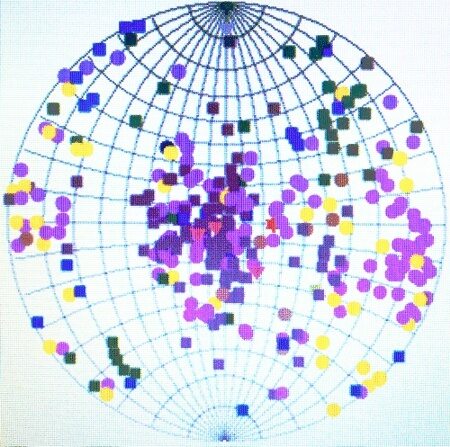
An example of one of a stereonet plot from one of the holes - looks like quite a cluster or horizontal fabrics there!
Graduation 2019
14 May 2019
34 Graduates in Earth and Environmental Science at May Graduation
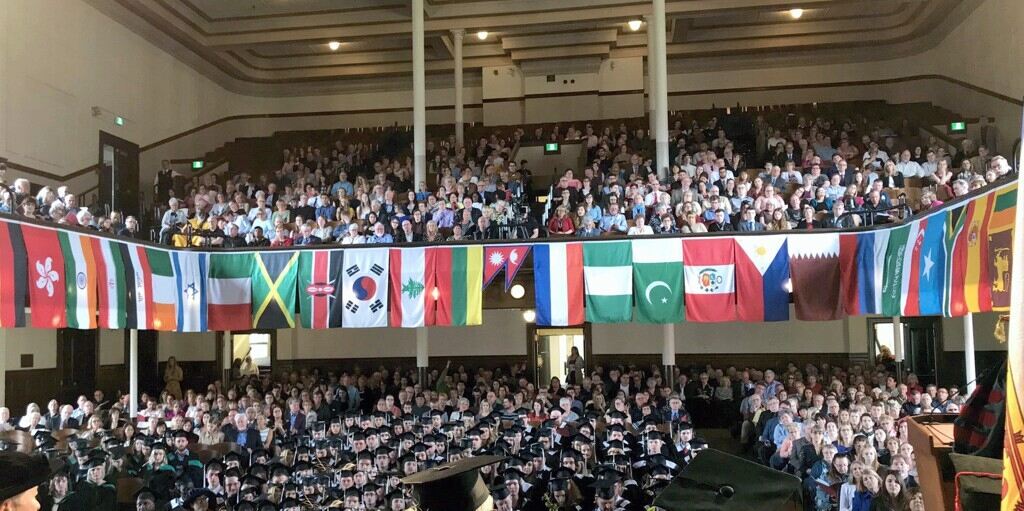
In spite of the cool and breezy weather, spirits were high as graduating students and proud family members attended the graduation ceremonies at Acadia University. In all, 32 BSc degrees and 2 MSc degrees were recognised from Earth & Environmental Science at the May convocation at Acadia, comprising 2 MSc (Geology), 8 BSc Honours (Environmental Science), 2 BSc Honours (Geology), 11 BSc (Geology), 8 BSc (Environmental Science) and 3 BSc (Environmental Geoscience). In addition, two graduates from last year had their degrees converted to honours, following their completion of a thesis over the past year.
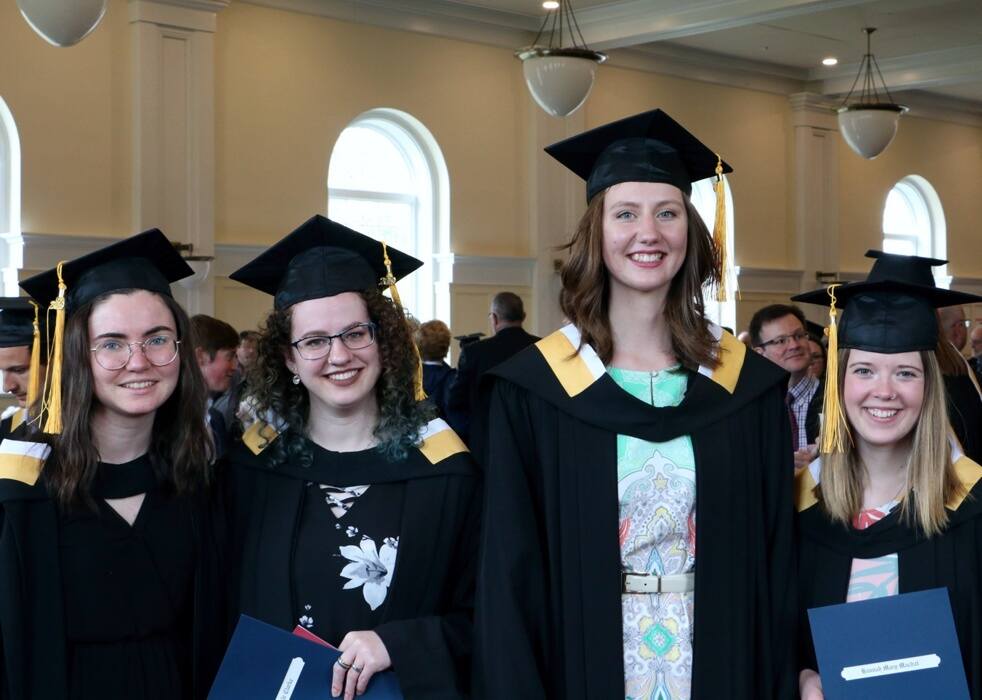
Four Environmental Science honours alumnae, Megan MacIsaac, Rachel Clarke, Baillie Holmes, Hannah Machat at the reception after graduation. All four were also Irving scholars. Photo by Dave Kristie.
Particular honour went to Philicity Byers, winner of the University Medal in Environmental Science, and Garrett Velkjar, winner of the University Medal in Geology and recipient of the Mining Society of Nova Scotia Centennial Medal.

Abraham Gesner statue unveiled
9 May 2019
The statue of Abraham Gesner was officially unveiled on Saturday, 4 May 2019.
(Thanks to Martha Hickman-Hild for all photographs.)
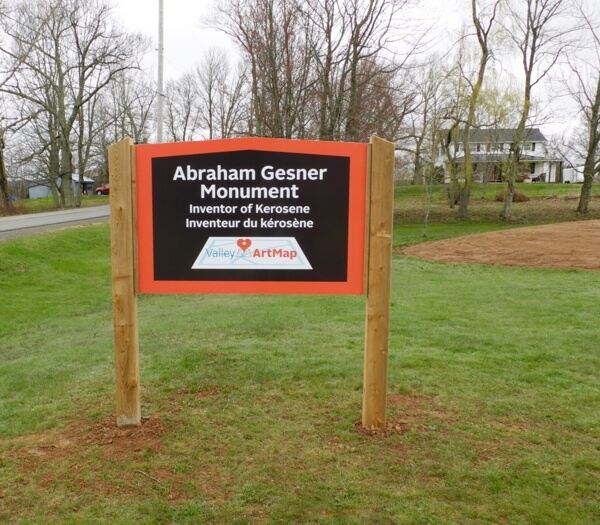
New roadside sign with Gesner homestead in the background.
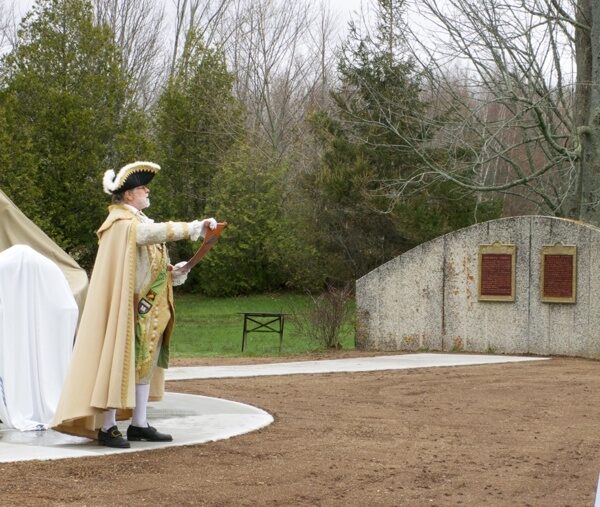
Kings County town crier reading Gesner proclamation.
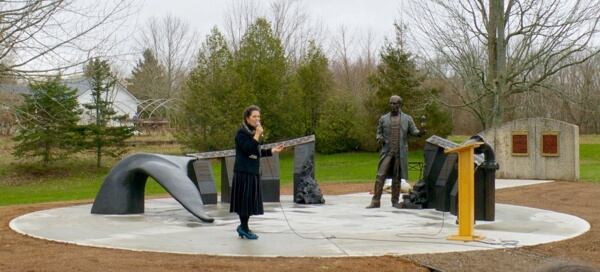
The artist, Ruth Abernathy, describing her creative process.
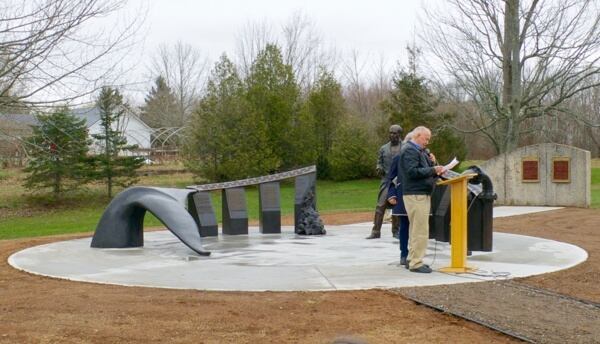
Dr. Dan Paul recounting Gesner's humanitarian contributions.

Martha Grantham of AGS speaking about Gesner's scientific contributions.
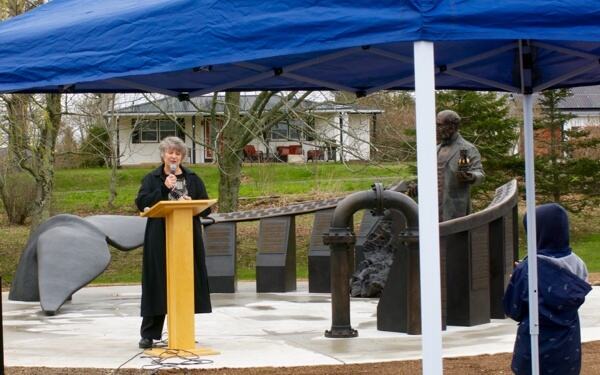
Martha Grantham with the Gesner homestead in the background.
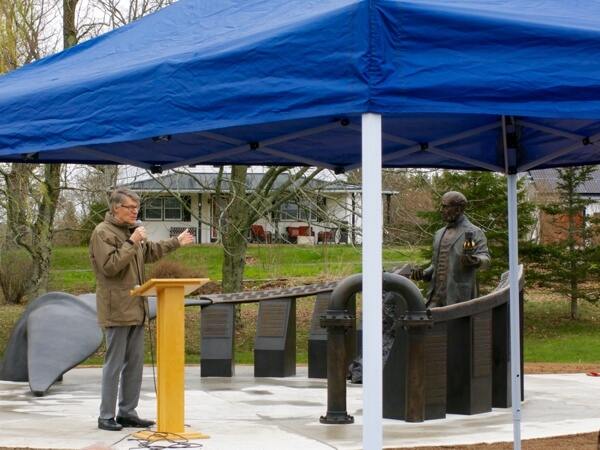
Project benefactor Allen Eaves talks about the potential for a Gesner museum in the old homestead.
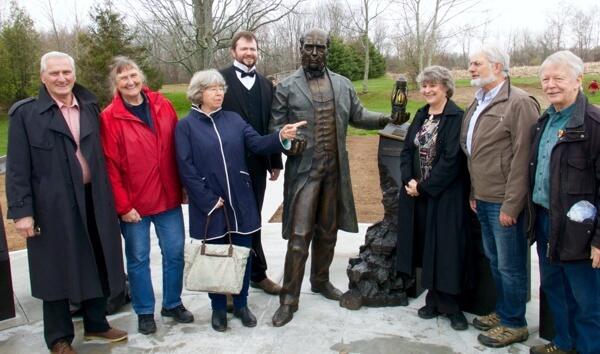
Geologists gather around the new statue, joined by a local actor who portrayed Gesner during the ceremony (from left: Terry Hennigar, Sandra Barr, Elisabeth Kosters, Alan Slipp, Abraham Gesner, Martha Grantham, Grant Wach, Bob Grantham).
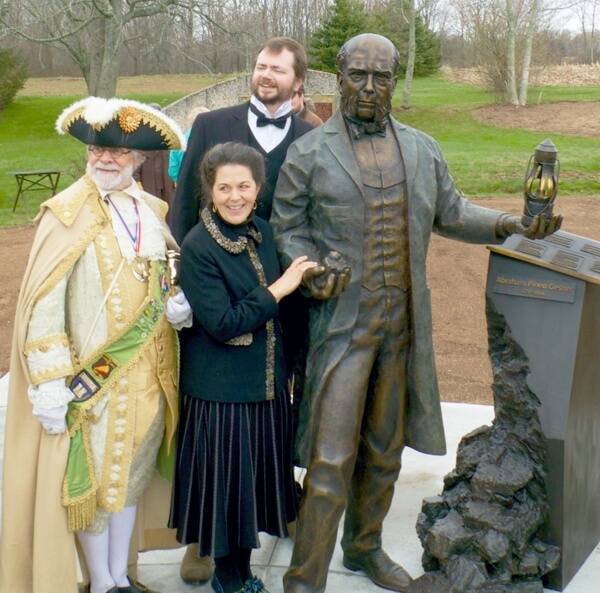
Key players in the ceremony: the town crier, the artist, the actor and Abraham Gesner.
Environmental Science Field School 2019
8 May 2019
Eight ENVS students successfully completed the ENVS2523 field school this spring. The Department of Earth and Environmental Science places a high value on teaching our students practical field skills and hands-on training in a multidisciplinary program. This multidisciplinary field course included training from faculty from Acadia as well as external experts (both government and NGO).
The students had an excellent field school program this year covering many environmentally relevant topics including geological mapping, salt marsh and upland forest risk assessment and ecology, scientific experimental design, quality assurance and quality control in science, sediment sampling, limnology and water quality, invertebrate collection and identification, and plastic pollution analyses.
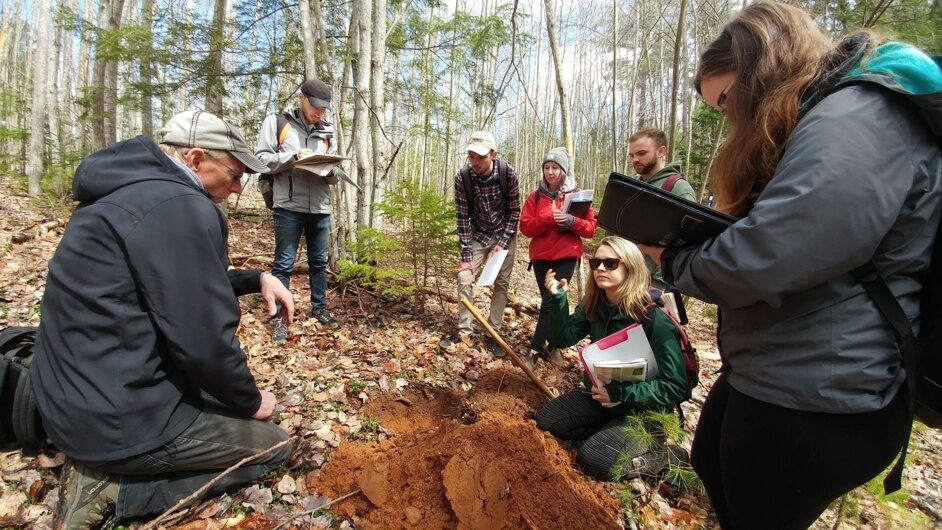
Nick Hill and Peter Neily teaching salt marsh and forest assessment to ENVS 2523 field school students.
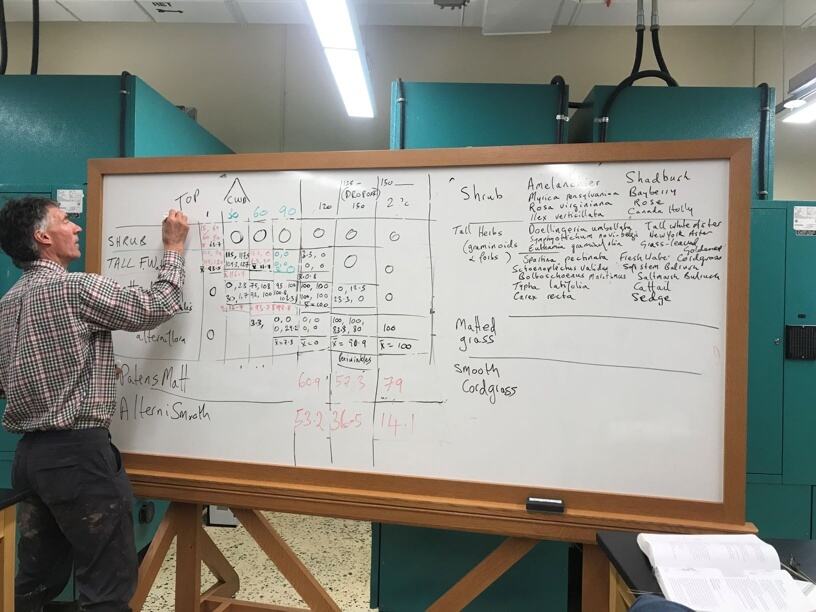
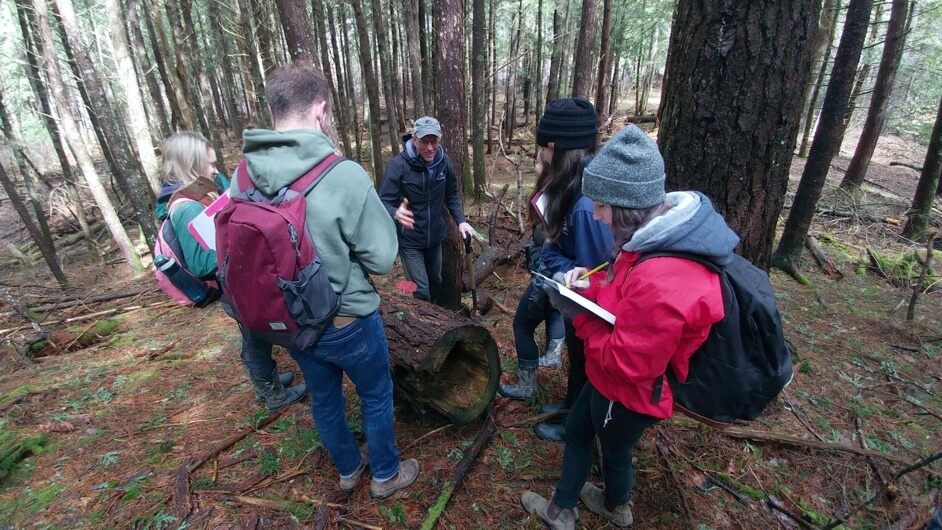
Students collecting salt marsh sediment cores to examine pollution distribution.
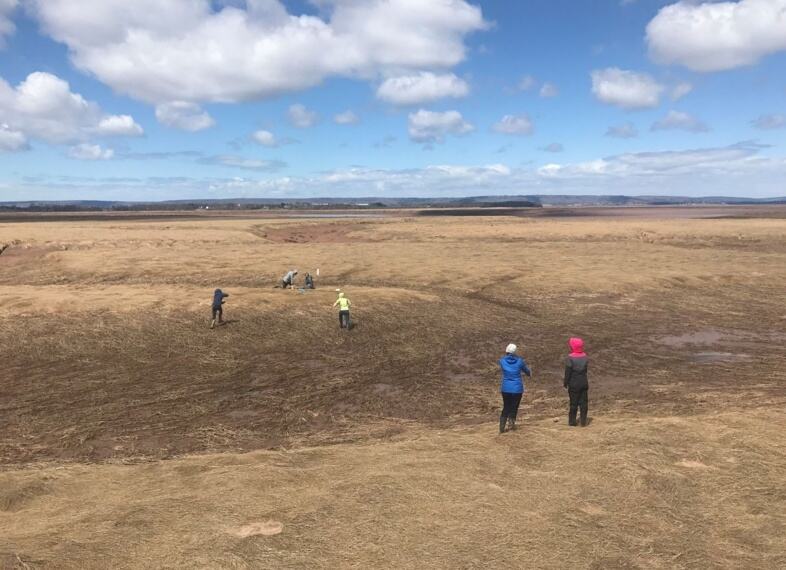

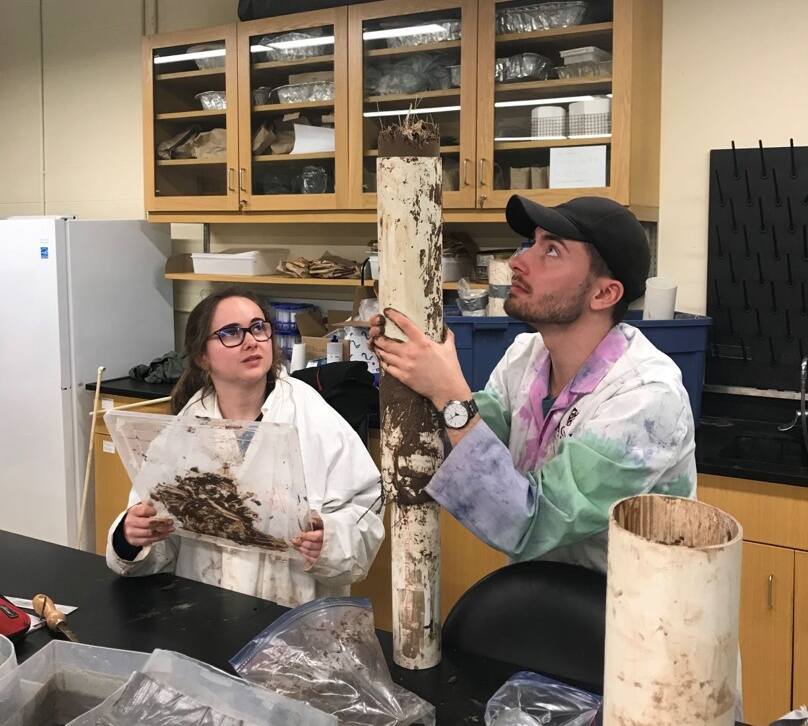
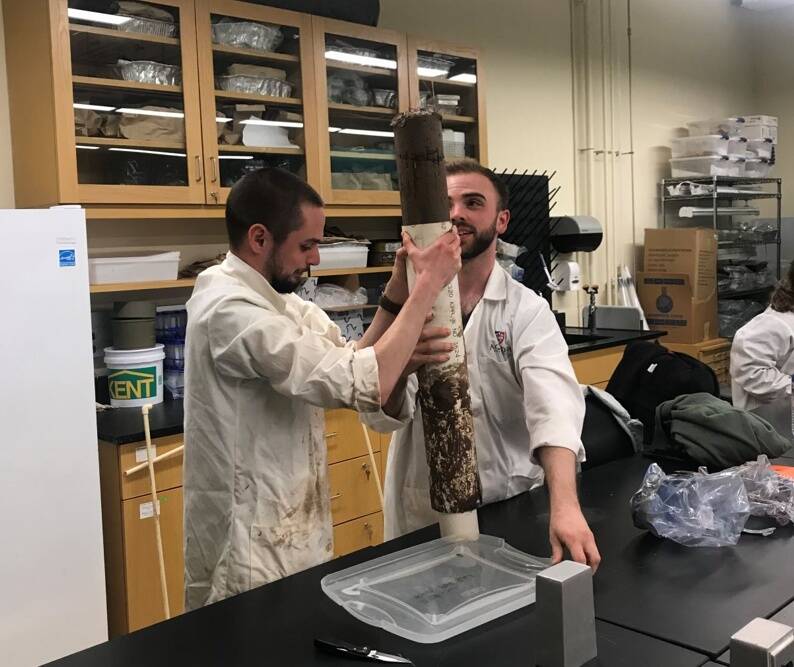
Entomology collection techniques and identification with ENVS2523 field school students. Thanks to Dr. Kevin Cloonan from Hillier lab.
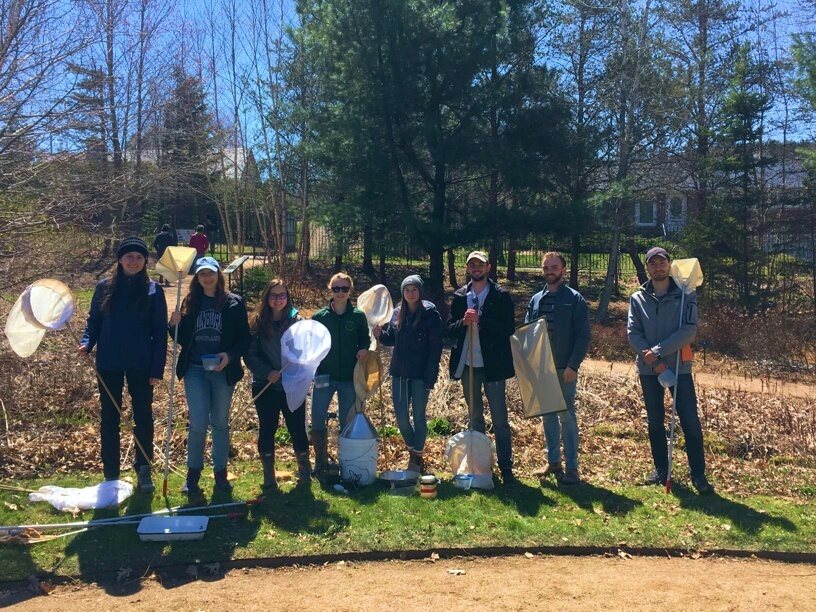
Limnology day in ENVS2523 field school at Acadia. Environmental science students examining the water quality in the Gaspereau lake system.
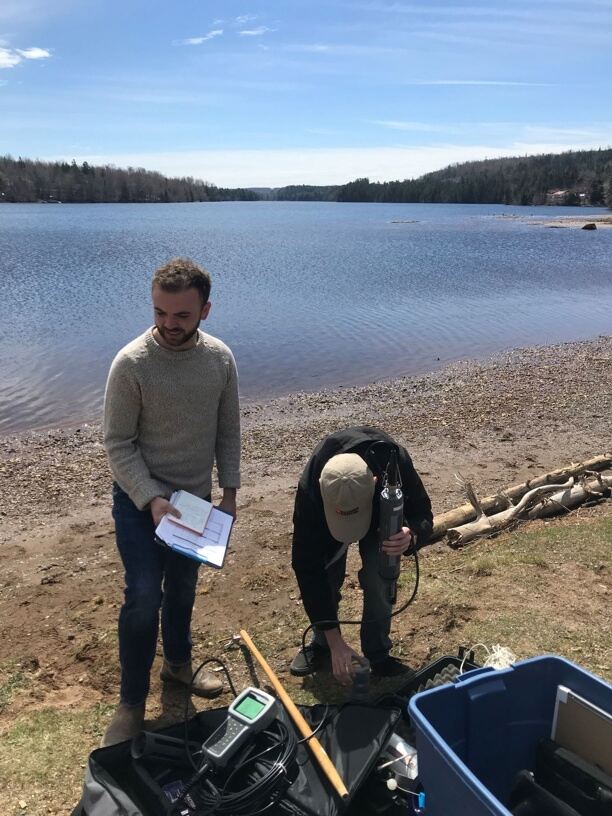

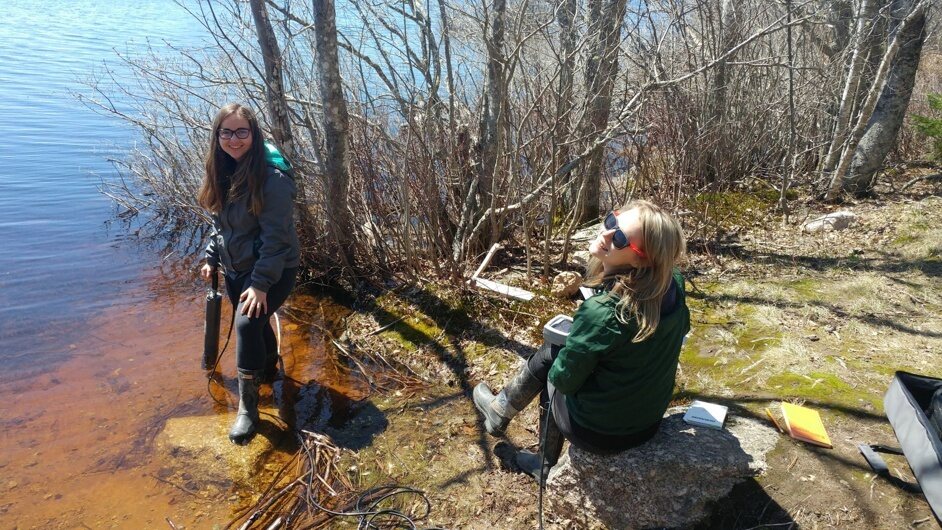
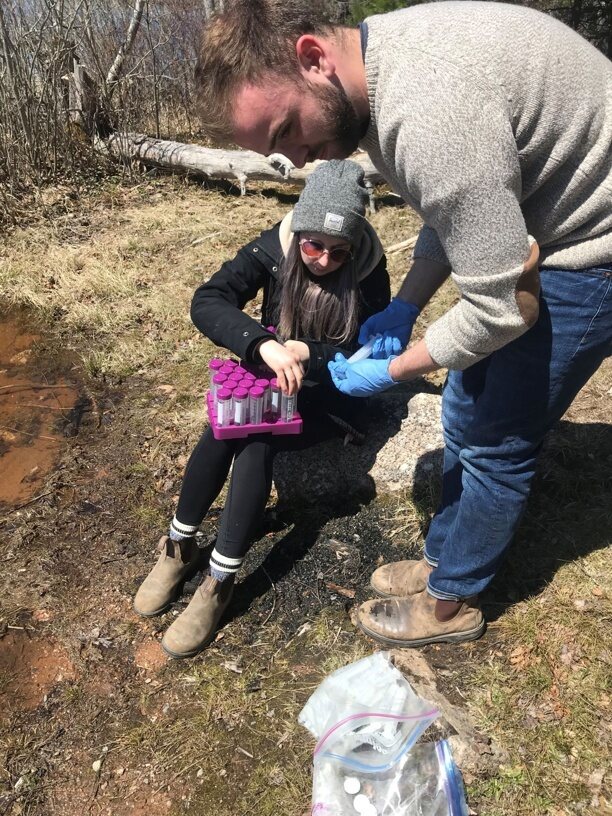
Module focused on plastic pollution on the land and in birds and seabirds with Dr. Mark Mallory.
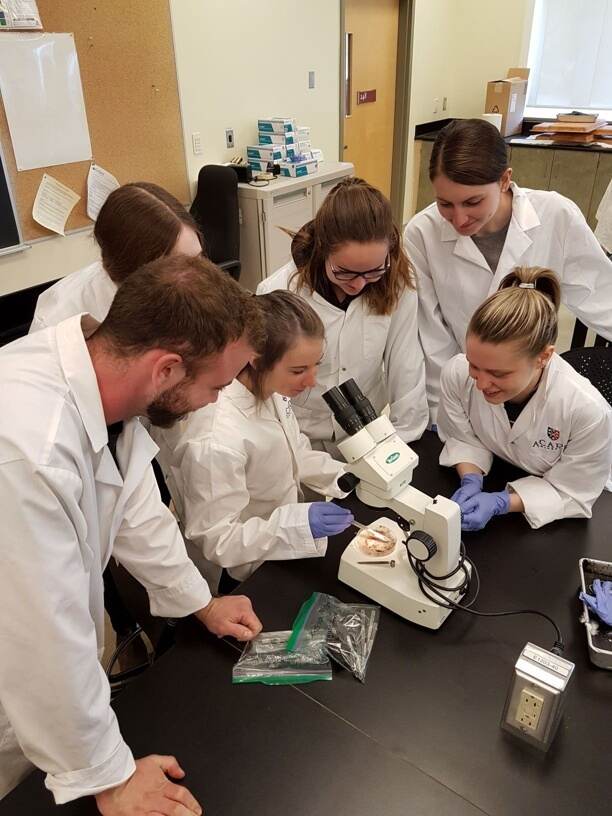
Field school 2019 comes to an end
5 May 2019
With the sun setting into the Gulf of St. Lawrence, field school 2019 comes to a conclusion. Having experienced torrential rain in Elderkin Brook, frigid winds off the sea at Georgeville, and brilliant sunshine on the barrens at Whitehead, the students can safely say they experienced the full range of conditions as they learned mapping techniques.
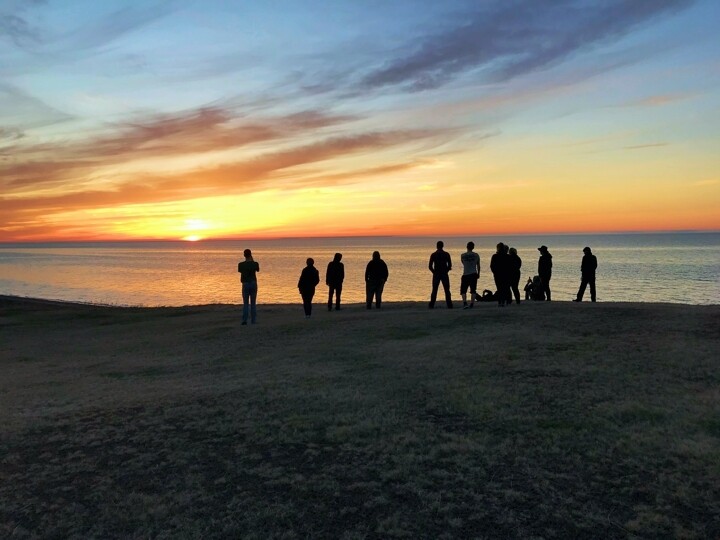
The last night at Camp Geddie provided another fiery sunset.

Students working on the details of the faulted dyke.
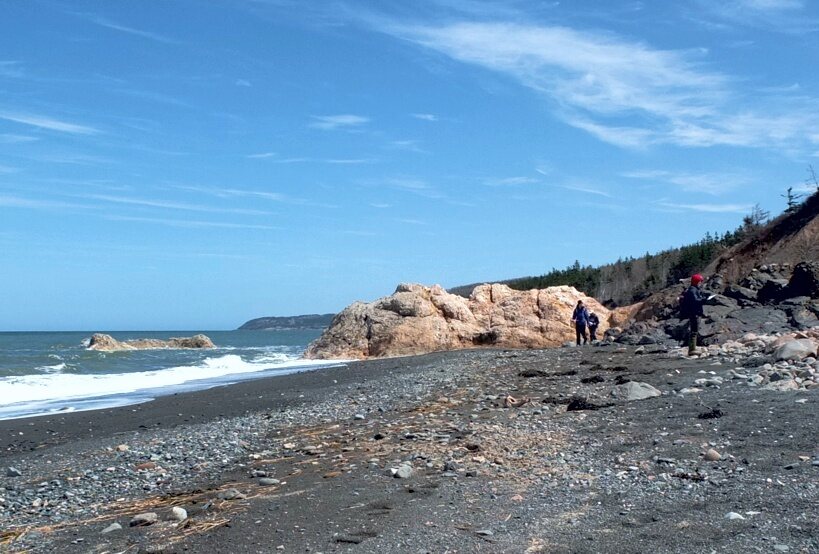
Sunshine on the beach at Georgeville
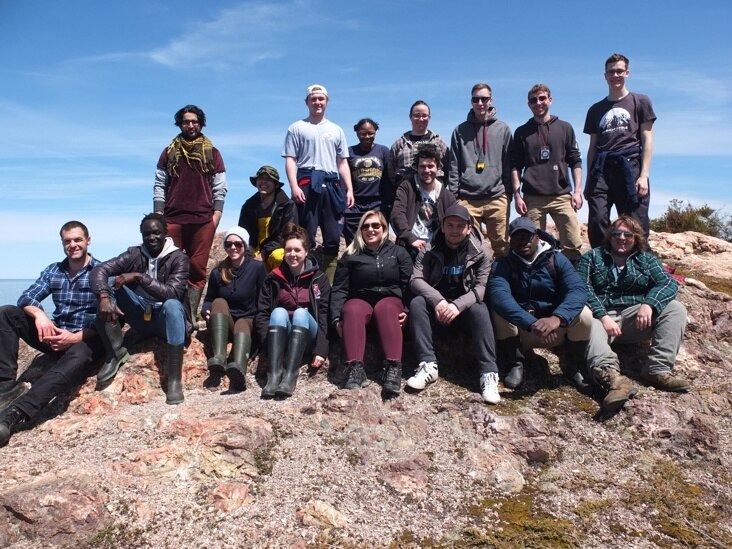
The whole field school at Arisaig
Jackson Malone awarded a Geological Society of America Graduate Student Research Grant
3 May 2019
Acadia graduate student Jackson Malone has been awarded a Geological Society of America Graduate Student Research Grant. Alongside his supervisor, Dr. Peir K. Pufahl, Jackson is studying biogeochemical cycling and its connection to mass-extinction and glaciation at the Ordovician-Silurian boundary. Jackson will begin field work in Wisconsin this June.
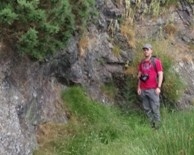
Unveiling of Abraham Gesner statue
1 May 2019
A Whale of a Tale is arriving on Middle Dyke Road, Kings County, May 4th, 2 p.m.
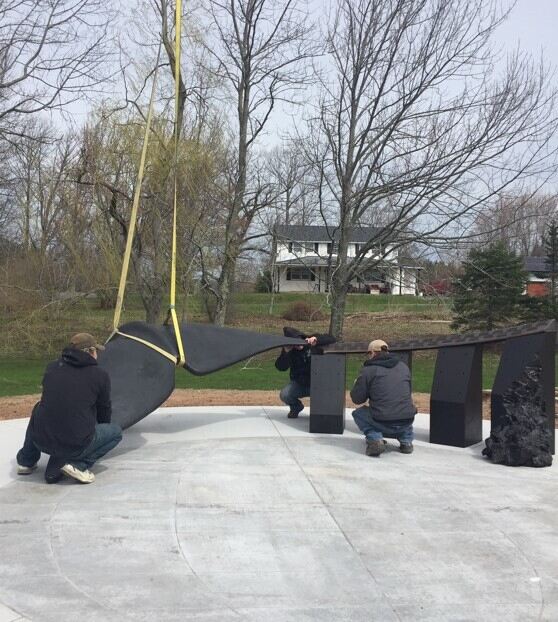
Kings County, NS: Thanks to a generous start-up amount from a donor and support from three levels of government, a large bronze monument narrating the story of Dr. Abraham Pineo Gesner, the ‘Father of the Petroleum Industry’ is to be unveiled on Saturday, May 4, at 2 p.m.
Dr. Allen Eaves, President and CEO of Stemcell Technologies, is that donor. When he stumbled upon an inconspicuous plaque about Abraham Gesner at Chipmans Corner, he immediately thought, “there must be a better way to recognize a Nova Scotian whose work changed the world.”
Eaves’ promise of fifty percent of production costs lead to the formation of a local committee to find the remainder required. Canadian Heritage and Multiculturalism, through its Arts and Heritage program contributed $158,000.
“The Government of Canada is proud to support commemorative projects such as this, which highlight significant milestones in the history of our communities,” said the Honourable Pablo Rodriguez, Minister of Canadian Heritage and Multiculturalism. “These projects remind us of the people, places and events that have shaped our great country. We are delighted to help create a lasting legacy for Kings County and its residents.”
The Nova Scotia Department of Communities, Culture and Heritage and the Atlantic Geoscience Society also provided financial support.
The production of a multi-dimensional sculpture by Ruth Abernethy, featuring Gesner’s scientific contributions, his life, and his societal concerns, is now complete. A licence from Parks Canada permits the bronze to be installed on the Gesner commemorative site, which is located next to the home where he was born in 1797.
Abernethy says, “You don’t usually equate a whale’s tail with petroleum, but that is where my design began.” She describes Gesner as, “A man beyond his time, a family man, and someone you could warm your hands on.”
Her creation demonstrates how the invention of kerosene decreased the need to hunt the right whale for its oil and led to the distillation of fuels and the invention of many products like asphalt and plastics. In both official languages, the monument chronicles Gesner’s explorations of the physical landscape, agriculture, medicine, his positive relationships and concern for the Mi’kmaq people, and his links to emerging industries.
Importantly, the Government of Canada is also providing a $36,747 non-repayable contribution, through the Atlantic Canada Opportunities Agency (ACOA), to help promote this extraordinary monument to visitors. The installation will be the centrepiece of a multi-location digital arts and culture trail.
“The trail, with its 18 exhibits, showcases the heritage of the Annapolis Valley and the unique work of local artisans,” said the Honourable Bernadette Jordan, Minister of Rural Economic Development, on behalf of the Honourable Navdeep Bains, Minister of Innovation, Science and Economic Development and Minister responsible for ACOA. “Using innovative digital-based technology creates a rich, interactive experience that will encourage visitors to travel to rural communities year-round and extend their stays in the area, promoting regional economic growth.”
Measuring an impressive 23 feet in diameter, it will be unveiled to the public at a ceremony to be held at 292 Middle Dyke Road, on Saturday, May 4, at 2 p.m.
Councillor Pauline Raven, Chair of the Gesner Organizing Committee, believes attendees will be thrilled by the scope and beauty of this project and “able to put their hands on history.”
The festivities will be hosted by Mayor Peter Muttart who is expressing: “Gratitude for everyone’s determination to see this to fruition, particularly Dr. Eaves who, cognizant of his own Kings County roots, employed his love of arts, culture and innovation, to enhance our region.”
The ceremony will include: a proclamation by honorary town crier Lloyd Smith; music by honorary bagpiper Ed Coleman, both for the Municipality of the County of Kings; the unveiling; a short drama; an overview by Abernethy; and much more. Come one, come all.
In the event of inclement weather, a quick unveiling will be followed by presentations at the Port Williams Community Centre, 1045 Highway 358 (Main Street), Port Williams, NS B0P 1T0.
The Municipality of the County of Kings is the third largest municipality in Nova Scotia. Kings County’s political and administrative decision-making structure includes an elected Mayor, nine Councillors, standing and special committees, operating and support departments, as well as funded agencies, organizations and special purpose authorities. The Gesner Organizing Committee members were: Councillor Wendy Elliot, Town of Wolfville; Dr. Elizabeth Kosters, Atlantic Geoscience Society; Councillor Pauline Raven (Chair), Municipality of the County of Kings; and Geof Turner, Kings-Hants Heritage Connection.
Report from Bermuda Field School
29 April 2019
We received a few images and very few words from the GEOL 4303 field course in Bermuda.
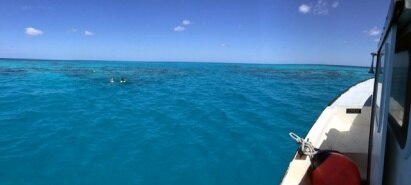
The weather for the Bermuda carbonates field school has been great, this picture shows students getting ready to dive to the reef just off of the coast of Bermuda.
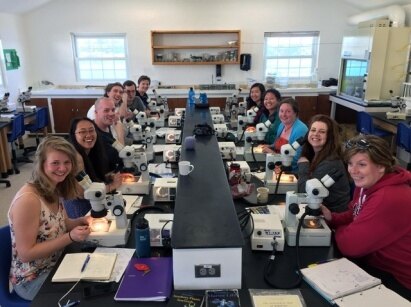
Queens and Acadia students in the lab examining field samples collected during the day.

The 2019 Bermuda carbonates field school class.
Field school 2019
28 April 2019
Field schools for 2019 are well under way at Acadia - for the first three days both the Environmental Science and Geology field schools combine for exercises on local outcrops.
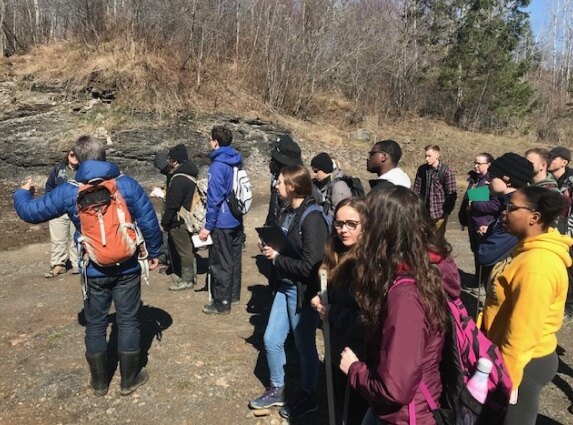
Here students listen in for instructions on the day's work from Dr. Ian Spooner (gesticulating) on the glass sand outcrops near Hantsport.
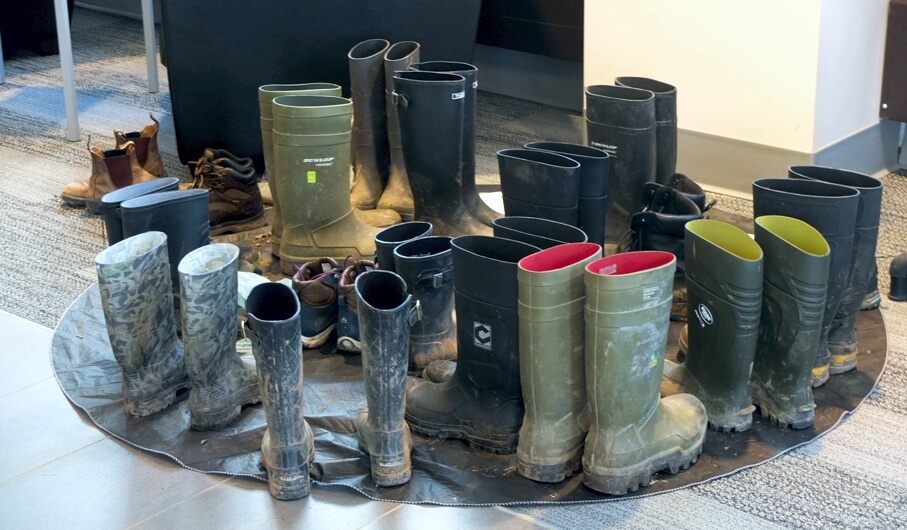
Boots waiting for another day in the field.
Letter from Norway - Riley Scanlan's visit to the Svalbard Global Seed Vault
23 April 2019
Riley is currently on an exchange program, studying at the Norwegian University of Life Sciences (NMBU) in Ås, Norway. Her interest in Svalbard, however, stems from her involvement in the Acadia University Seed Bank, where she began as a volunteer in October 2016. Dr. Robin Browne, a propagation specialist who oversees operations in the seed bank, encouraged her to reach out to professors at NMBU in hopes of arranging a visit to the Svalbard Global Seed Vault, located in Longyearbyen, Svalbard. As the Acadia Seed Bank steadily grows, we are looking for more long-term storage of seed accessions, and so contact with the Svalbard Seed Vault is a perfect opportunity for Acadia to establish communication and hopefully deposit seeds.
She writes:
Stepping out of the plane onto the runway, I was greeted by horizontal winds and a ring of mountains towering overhead. I had landed in Svalbard, Norway, an Arctic desert island located halfway between mainland Norway and the North Pole. Once I gathered my bearings, stunned by the already amazing landscape, I found my way inside to meet my host for the next four days. Åsmund Asdal, Coordinator of Operation and Management, Svalbard Global Seed Vault, kindly invited me to stay with his team in their guesthouse in Longyearbyen, Svalbard. This arrival may sound simple and pleasant, but in fact my journey to Svalbard was a long venture.
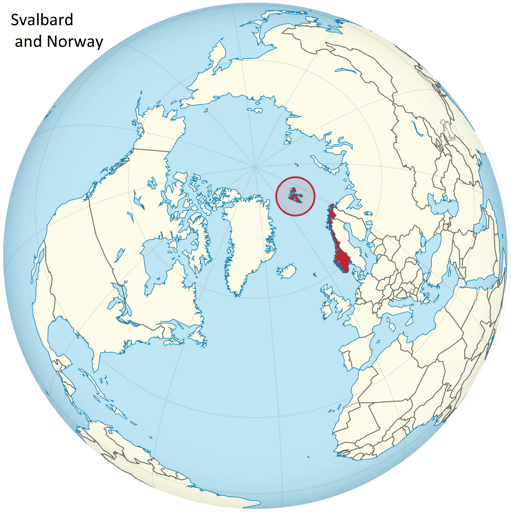
Security surrounding the vault, however, is extremely tight and nowadays only a handful of full-time employees are allowed to enter the vault, three to five times a year, to deposit seeds. I could not simply knock on the door and ask for a tour, so I needed to get in touch with the right people.
My General Ecology professor here at NMBU, Erik Aschehoug, graciously assisted me in this undertaking. After a few meetings of getting names and emails, which led us to further names and emails, we reached Åsmund. Åsmund, my host in Svalbard, works with Nordic Genetic Resources Centre (NordGen), which along with the Norwegian Government and the Crop Trust, is responsible for the Global Seed Vault.
Åsmund quickly replied that his next planned trip to Svalbard would be in a few weeks, to deposit a seed collection from South Africa, and I was welcome to join if I found my own way there. This posed challenge number two. Let me state I absolutely enjoy and treasure my time in Norway, but if there is any pitfall I have come to know, it is this: everything is ridiculously expensive. A return flight from Oslo to Svalbard, on set dates, booked just over a week prior, is by no means an exception to this conclusion. Dr. Ian Spooner, Head of Earth and Environmental Science department at Acadia, agreed to support me through this final hurdle, for which I am so grateful.
With my ticket finally in hand, I set out on a great northern adventure!
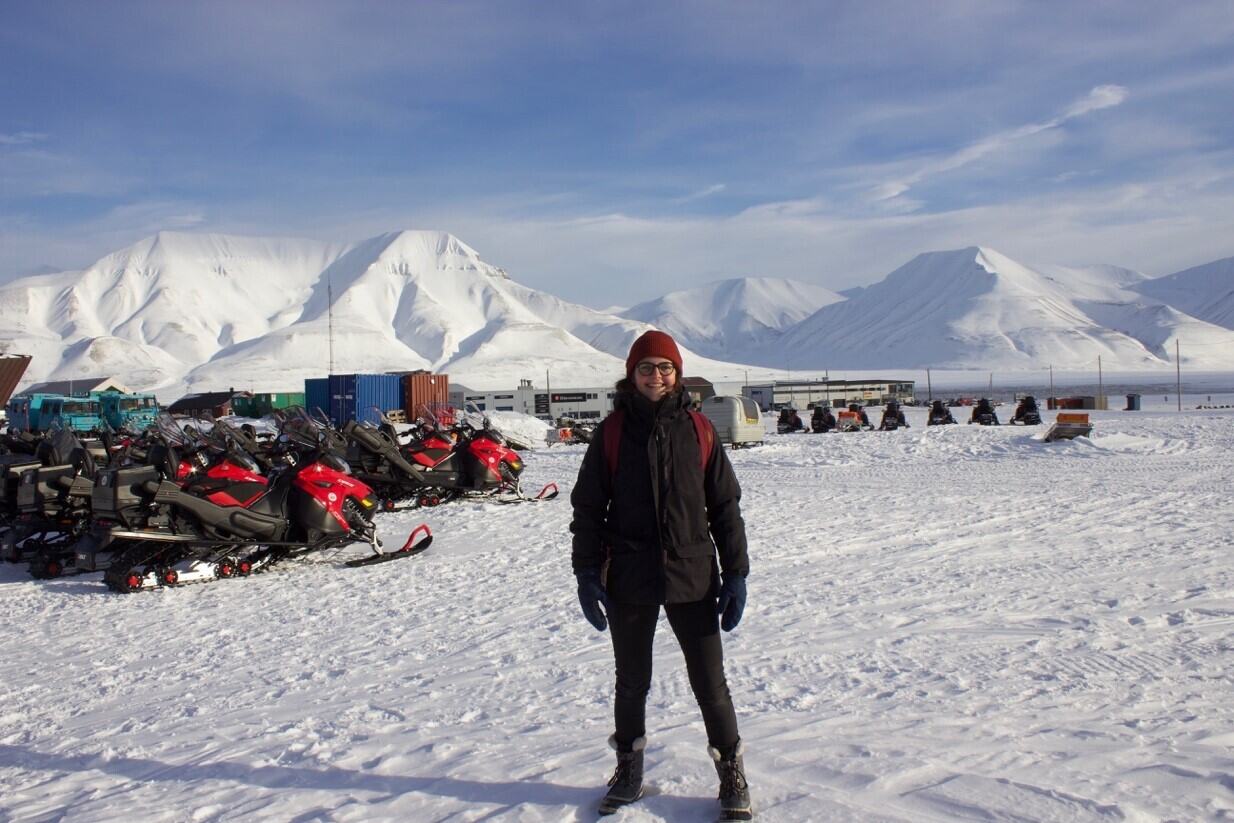
Located at 78°N, Svalbard is one of the northernmost permanently inhabited places in the world. I was fascinated to learn about the development of this isolated and remarkable terrain. Since its discovery in the 16th century, Svalbard has been home to only a few temporary settlers, who were mainly interested in whaling and trapping. However, industrialization began around 1900 as coal mines were established. Interestingly, not until the creation of the Svalbard Treaty in 1920 was the area ruled by any governing body. The Svalbard Treaty, an outcome of the Paris Peace Conference, grants Norway sovereignty over Svalbard, ensures the territory not be involved in a war, and allows signatory countries rights to economic resources on Svalbard (Canada is one of them!).
With only 2600 permanent residents, the effects of this unusual and recent development of the region are tangible even today. There are no proper hospitals, so pregnant women must fly to the mainland to give birth; people are not allowed to die and be buried on Svalbard, because the soil is permafrost and a body will not decompose; the average length of residency on Svalbard is six years, and there are more polar bears on Svalbard than there are people so you must carry a gun if you leave the city limits of Longyearbyen. This lack of expansion combined with such a drastic and harsh climate makes Svalbard nearly inhospitable, but also makes it the perfect home for the Global Seed Vault.
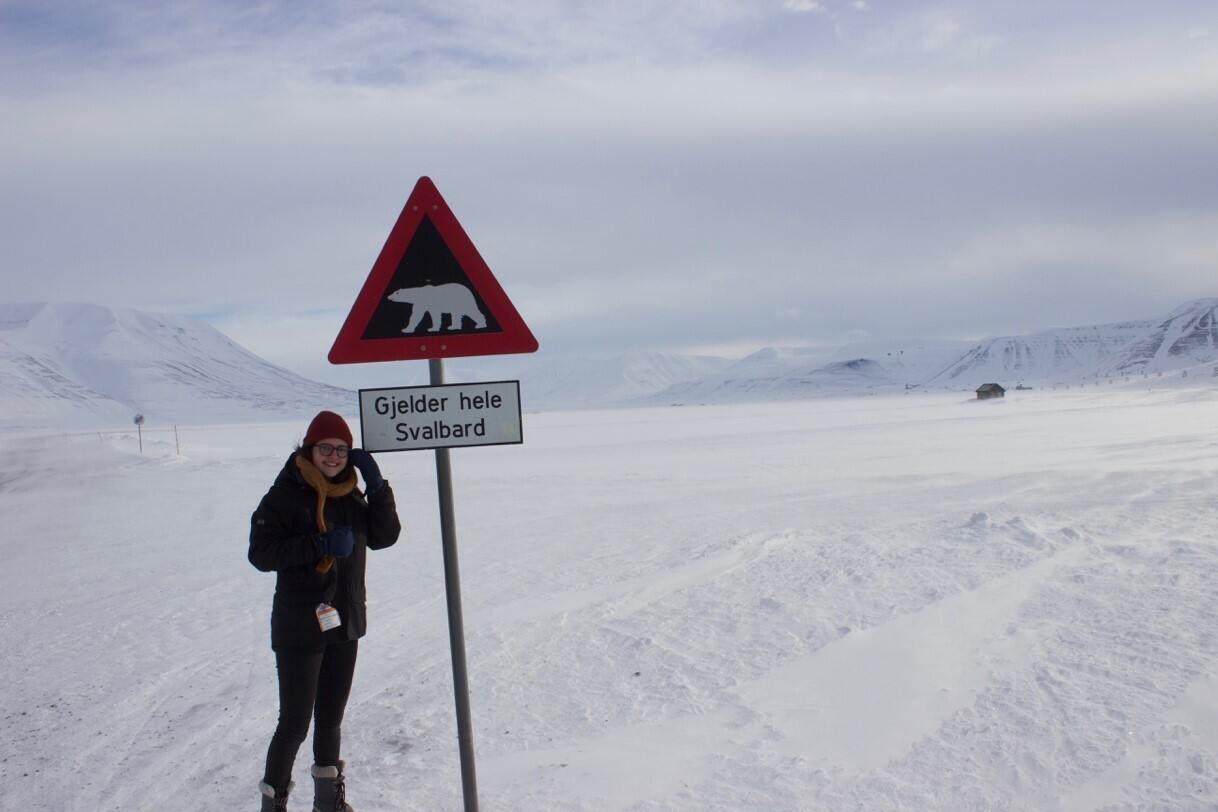
Translation: ‘Applies to all of Svalbard’. Essentially, beware of polar bears everywhere beyond this limit.
The Svalbard Global Seed Vault was established in 2008 by the Government of Norway. Broadly speaking, the purpose of a seed bank is to store plant material and seeds in order to preserve biodiversity against crises such as climate change and war. The Acadia Seed Bank preserves plants native to the Acadian Forest Region and includes multiple rare and endangered species. We continuously collect new samples and propagate current samples to grow our collection. The Svalbard Seed Vault, on the other hand, preserves in long-term storage the duplicates of seeds conserved in gene banks of crop or crop-related species. The Svalbard facility is built into the side of a mountain, deep in the permafrost. While Svalbard may seem too isolated a location for such sophisticated machinery, it was actually chosen to ensure the vault could withstand any possible conditions or climatic changes. It is commonly referred to as the ‘Noah’s Ark of seeds’.
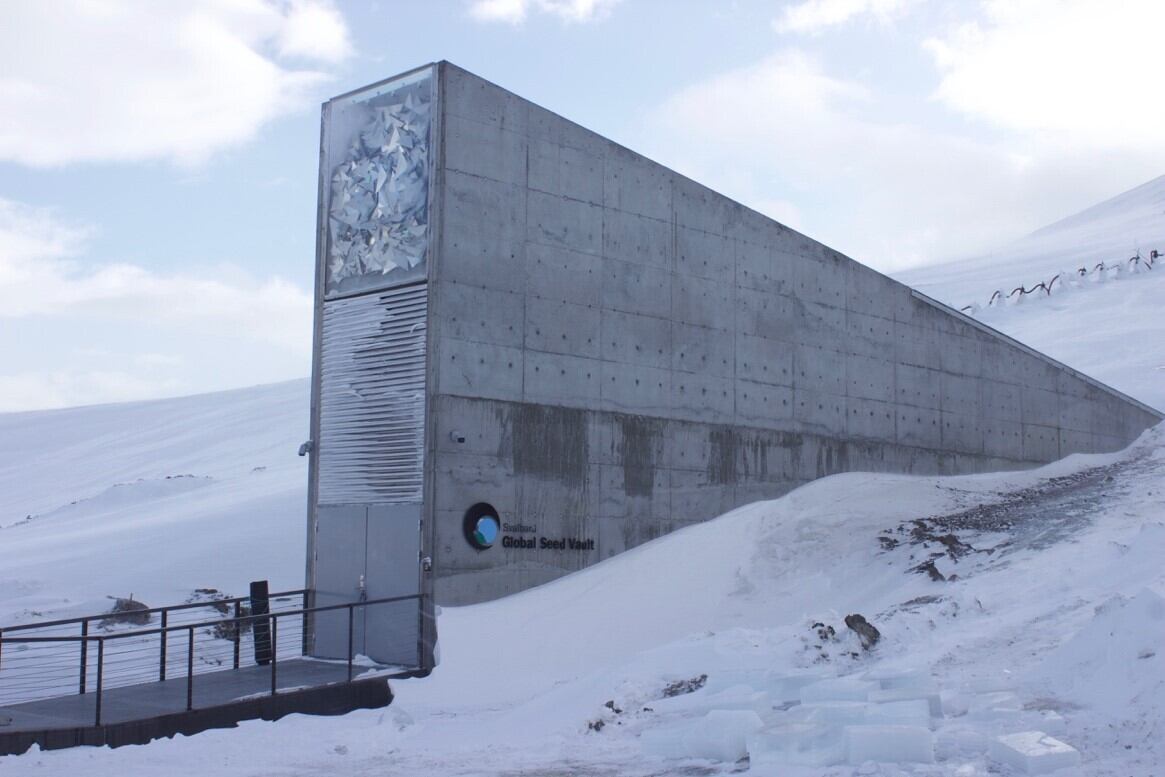
Seeds in long term storage must be frozen to ensure their viability. The building is run on coal (extracted from a nearby mountain in Longyearbyen!) and artificially maintains a temperature of -18°C in the storage rooms. However, the surrounding permafrost creates a constant temperature of -4°C, and so will protect seed survival if ever the building were to lose power. That said, the back-up generators are also good prevention against this. The vault is located high above sea level, and if even all current glaciers were to melt would remain above sea level. Furthermore, given that Svalbard is not legally allowed to participate in war in any way, it is safe from most all civil unrest. The high restrictions regarding access to the Seed Vault also prevent any damage to or attacks on the collections. At first glance, this may all seem a little overdone – it’s just to store some seeds, right? In fact, according to Åsmund, “if all seed samples in the Vault were lost, it would cost 5 billion NOK, [or 778 million CAD], just to regrow and send the seeds”. This figure does not take into account the actual value of these seeds to countries that may rely on them for agriculture. The Seed Vault has the capacity to hold 4.5 million seed samples, and currently houses over one million accessions of more than 5000 different plant species.
This magnificent, state of the art facility is almost entirely underground, and the door poking out of the mountain is perhaps a little underwhelming. Åsmund captured this sentiment well when he remarked, “well, it’s just an ordinary room, but holds extraordinary content”. There are seeds held in the vault from North Korea, whose contact person Åsmund has since tried to reach multiple times to no avail. Due to the civil war in Syria, the International Centre for Agricultural Resources in the Dry Areas (ICARDA), headquartered in Syria, has made a withdrawal from their collection in the Global Seed Vault to restore local crops. These seeds are vital to the preservation of many of the world’s crops and stored at Svalbard will survive well beyond any of us alive today.
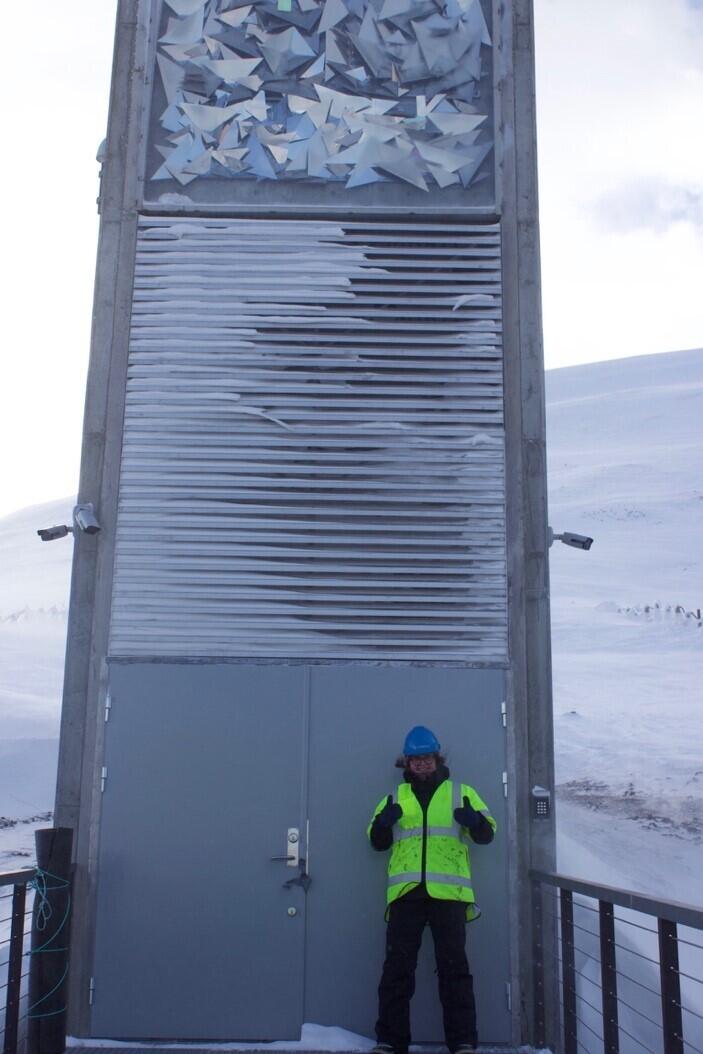
Going forward, the Acadia Seed Bank will remain in contact with Åsmund and NordGen to hopefully deposit seeds in the near future. While our seed bank does not focus on crop plants, we have multiple wild relatives of crop species that would be of particular interest to the Svalbard Seed Vault.
It is sufficient to say Svalbard is an incredibly special place. Few people have ever been there, and even fewer have been so close to the Seed Vault. I am indebted to everyone involved in making this opportunity come to life; never did I believe this would have been possible. Tusen takk!
For further information on:
Acadia University Seed Bank - https://kcirvingcentre.acadiau.ca/seed-and-tissue-bank-programs.html
Svalbard Seed Vault - https://www.seedvault.no/
NordGen - https://www.nordgen.org/
Sarah Stewart's honours work featured by Science Atlantic
22 April 2019
Acadia environmental science student Sarah Stewart’s love of the ocean has been a lifelong relationship. In fact, she loves it so much she’s made it her education, research and future career.
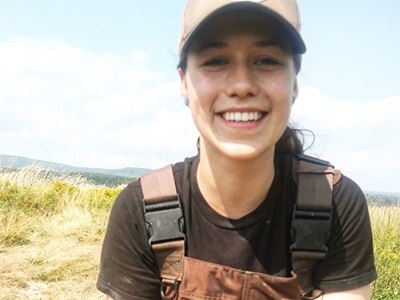
Sarah attended her first Science Atlantic Environment Conference at St. Francis Xavier University this winter and was the recipient of the second place Undergraduate Research Award for an oral presentation.
Sarah has recently completed her honours thesis under the supervision of Mike Stokesbury, where she made significant discoveries on the feeding habits of the anadromous alewife which travels from the Atlantic Ocean to the freshwater lakes of Aulac, NB during spawning migration. “It was previously thought that the fish don’t feed in fresh water when they are spawning because they are more focused on spawning. But I thought that was weird because they are going to need an energy source,” Sarah said. Her findings prove her suspicions were correct: “They do eat when they are spawning. They do a lot of filter feeding, eat zooplankton and opportunistically feed on larger macro-invertebrates.”
Sarah is looking forward to graduating this spring and is pursuing career opportunities in marine biology in the Maritime provinces.
Full story at Science Atlantic.
Charting long-term change in Whistler lakes
21 April 2019
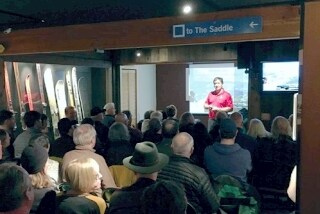
For several years now, Ian Spooner has been doing paleolimnology work on some of Whistler's lakes—taking core samples of lake sediment to understand both external and internal influences on the lakes.
"The reason I'm doing this talk is because I need stories. I do a lot of science on lakes ... but the science isn't worth anything without the stories," said Ian Spooner, head of the Department of Earth and Environmental Science at Acadia University, in a talk at the Whistler Museum on April 11.
More details at Pique New Magazine.
Alice Cohen featured in "Research Spotlight"
17 April 2019
In terms of research, what are you working on right now?
I’m writing a book with Andrew Biro about Canadian environmental politics. There are a few books on the subject, but they tend to focus on governments and government institutions as the be-all and end-all of environmental policy and decision-making. That’s only part of the picture.
For example, if you look at the debate over Northern Pulp in Pictou County: it’s not really about what the law says, or who’s in government. It’s about pollution, jobs, and how you make decisions as a community. Our book looks at not only the formal governance institutions but also economies, identities, and communities, and how they shape Canadian environmental politics more broadly than just the outcome of elections and what laws exist.
Andrew and I have both taught Environmental Politics classes here at Acadia, and we want to expand what’s out there. We both thought, “what book would I like to use to teach ?” We're trying to write that book.
Q: Anything else?
My second project is supported by a Harrison McCain award, and looks at the politics of knowledge with respect to water governance and how we make decisions about water
One of the trends that we're seeing in water governance is a move towards community-based water monitoring (CBM), which is where community groups who are concerned about something in their water will set up systems to monitor the waterways in their own community.
In 2016/17, I worked with collaborators in BC to survey more than 200 CBM organizations across Canada and asked questions about what they were testing for, how they were funded, who interpreted their results, what they were doing with their data, etc. A policy report and an academic paper came out of that, and a lot of people found it really useful because it was the first time this data had been collected and was available.
One of the interesting findings that emerged from the survey was that when we asked “why are you monitoring what you are monitoring,” the most popular answer was “because it's what our equipment can measure.” So the technology and funding programs are enabling communities to test their water – but they’re also dictating, in large part, what can be measured and what’s important. That’s an interesting finding, because most of the academic literature only talks about CBM as if its empowering communities to measure what’s important to them. And it is – but our research suggests that these programs are also being shaped by what the technology can measure and what their funders require. And often these programs are implemented to pick up on where provincial or territorial programs left off. So, it’s more complicated than communities just going out and measuring what they want to measure.
Q: It sounds like you work with groups across Canada and on issues that span the country. Does being at Acadia, all the way out here on the East Coast, compel you to reach out in order to be able to connect with people in your field?
Yes and no. I did my PhD at the University of British Columbia, so I have a lot of connections on the West Coast. And the water world is really small, so we're all in touch with each other.
On the other hand, I had crossed paths with Andrew Biro a couple of times before coming to Acadia. And when we started talking about doing this book project, I realized that I had never had the experience of working on a project with someone on the same campus before – at least not since my PhD – and neither had he. We decided that rather than writing our own pieces and sending them back and forth by email – which is what you would do if you were writing a book with a colleague on the other side of the country – we would actually sit down and write it together. So we meet once or twice a week – we block it off, like a real appointment – and we sit down for two hours and just write. It's probably my highest-words-per-week produced of any project I've ever worked on. It’s been really good.
Q: How do these projects fit in with your broader research agenda?
I could say that my research agenda is about water, but really it's not. What I’m really interested in is the relationship between people and place, and how different people, communities, and groups navigate that relationship. I have found water to be a very good tool for understanding that relationship.
In North America especially, there is this idea that there are people, and there's nature, and they are two separate things – but they're not. For example in Ontario, post-Walkerton, there are strong protections for any body of water that is a source of drinking water, which don’t apply to bodies that are not. But water doesn’t work like that: it mixes; it moves around. This false division is one of the themes Andrew and I are exploring in the book.
Q: Are there any key pieces of advice you give students before they embark on a research project?
Be excited about your research project, because you're going be sick of it by the end. If you don't love it at the start, I don't know how you’re going to make it through.
Q: What are you doing for fun these days?
I spent a lot of time skating on the Wolfville reservoir this winter. There’s a group of local volunteers who measure ice depth, and shovel and snow blow a big oval around the whole reservoir, so you can skate around it.
In the summer time, my partner Jamie and I sometimes go canoeing in the evenings. We go to the north mountain: Gaspereau Lake, Black River Lake. It’s really fun to get out on the water on those long summer evenings.
Chris White and Sandra Barr - best paper award in Can. J. Earth Sci.
16 April 2019
Chris White and Sandra Barr, along with co-author Ulf Linnemann, from Dresden, Germany, will be recognised at the annual meeting of the Geological Association of Canada in Quebec in May as the authors of the best paper in the Canadian Journal of Earth Sciences in 2018. This annual award is jointly by the NRC Research Press and the Geological Association of Canada for the “Best” paper published in the journal within a calendar year (volume year). The paper is entitled U-Pb (zircon) ages and provenance of the White Rock Formation of the Rockville Notch Group, Meguma terrane, Nova Scotia, Canada: evidence for the "Sardian gap" and West African origin.
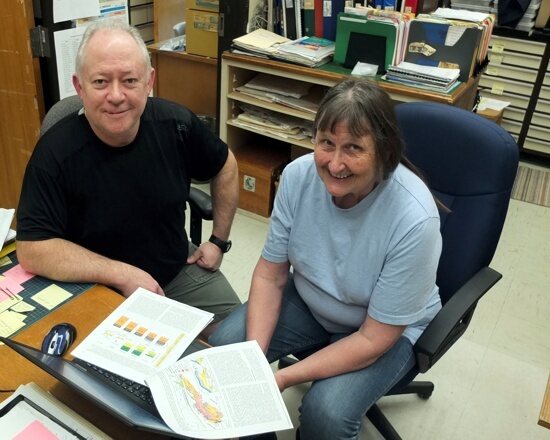
Sandra and Chris reviewing the finished paper.
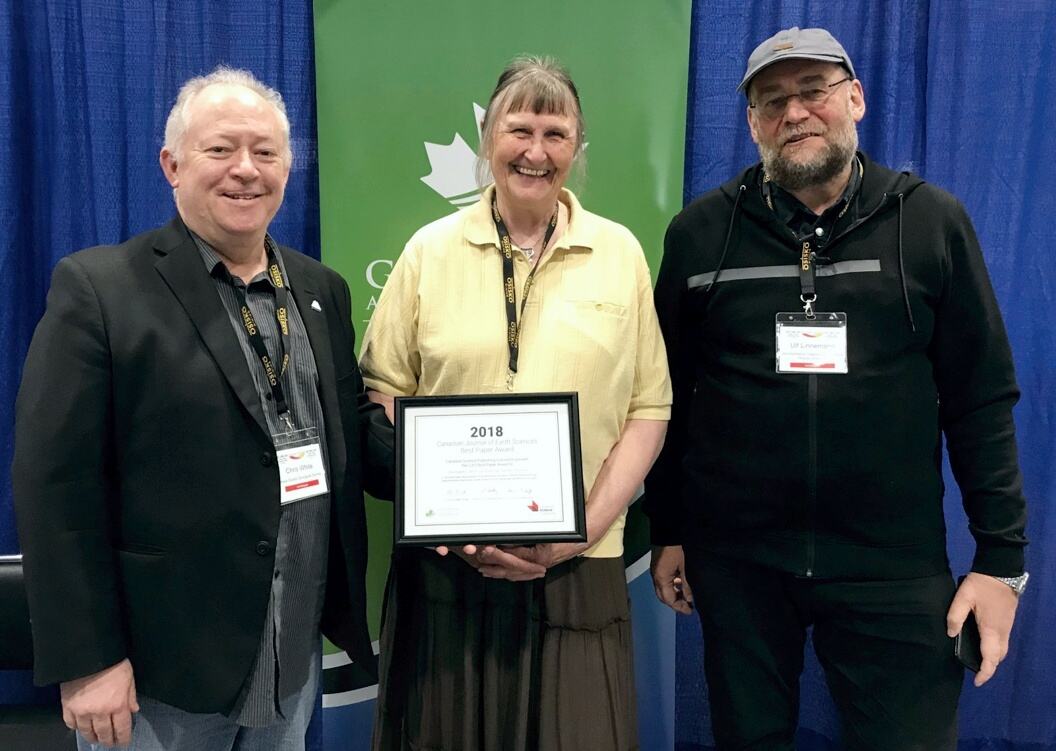
Chris, Sandra and Ulf Linnemann receiving the award at the GAC-MAC conference in Quebec City
Ring Ceremony 2019
9 April 2019
Thirteen soon-to-graduate students received their Earth Science rings at a ceremony in Dalhousie University on 5 April.
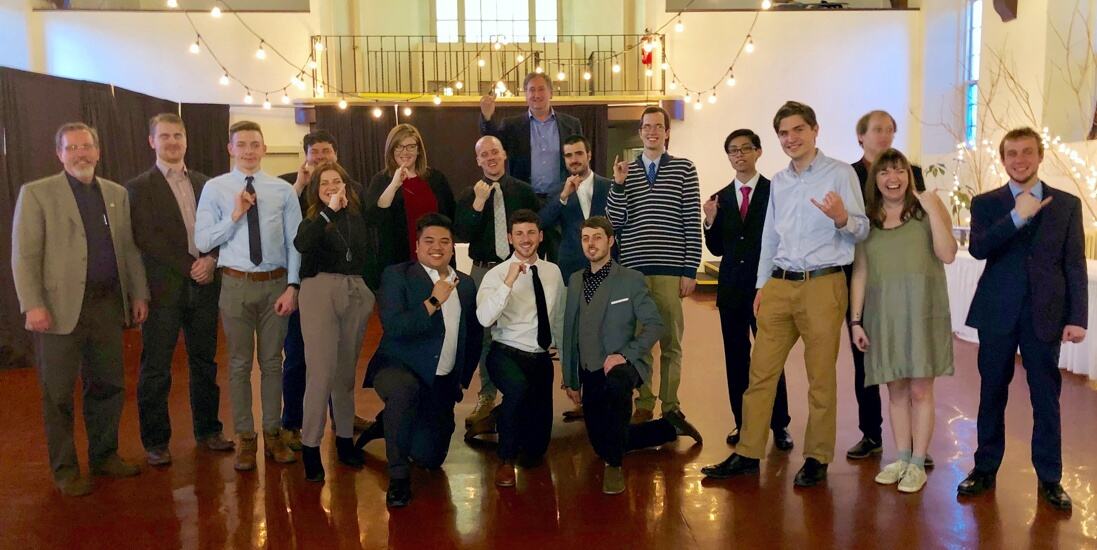
Pictured here are (standing, from left) Cliff Stanley, Garrett Hooey, Tristan Townsend, Peir Pufahl, Ashton Baich, Jennie Pushie-Burgher, Mark Fry, Ian Spooner, Miguel Vaccaro, Jonathan Publicover, Sam Zhao, Michael Tamousauskas, Braeden Gray, Rachel Lewis, Justin Sinclair. Kneeling are Anthony Chu (photographer), Alex Whitney, Jesse Cote.
Rachel Clarke receives an NSERC graduate scholarship
1 April 2019
A big congratulations to Rachel Clarke on receiving an NSERC CGS graduate scholarship today for her MSc work examining mercury photoreactions in estuaries! These are important graduate awards and a very impressive addition to her CV. Well deserved and great work! Feel free to high-five her in the hallways.
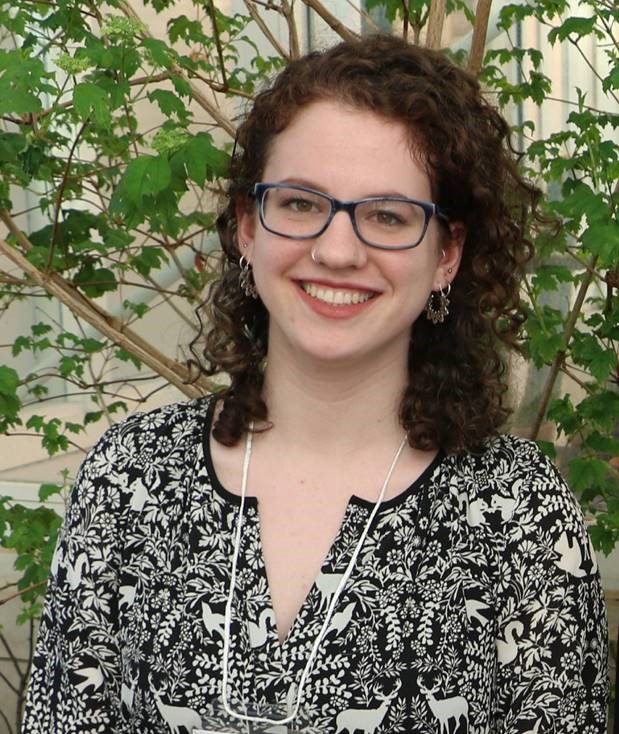
Year-end banquet 2019
1 April 2019
On 29 March, the Environmental Science Student Association (ESSA) and the Fletcher Geology Club combined forces to organize the annual end of year banquet in the Clark Commons. About 45 students and professors enjoyed the three-course dinner and a visit from two distinguished alumni.
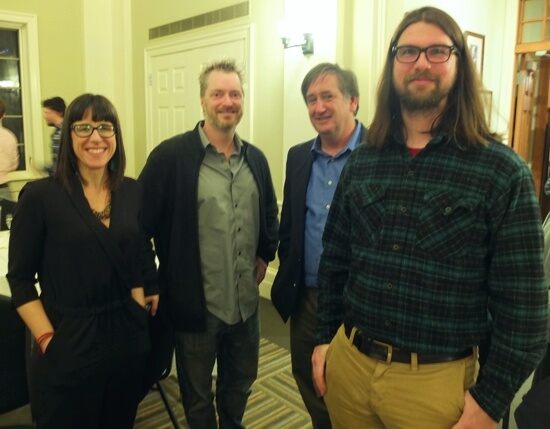
Speakers at the event were Maylia Kempt Parker (left ) and Dewey Dunnington (right), here chatting with Nelson O'Driscoll and Ian Spooner. Maylia has worked in the environmental consulting business in New Hampshire, Prague, and Halifax, and is now is Director of Air Quality & Resource Management, Nova Scotia Environment. Dewey is working toward a PhD at Dalhousie University.
Also at the event, various prizes were announced or given out: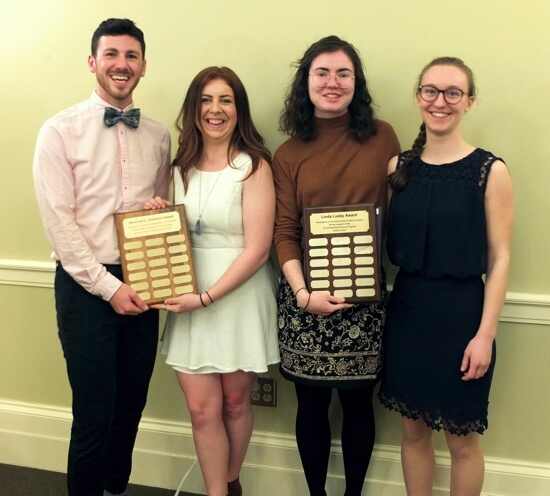
(from left:) Winners of the Harcourt Cameron Award were Alex Whitney and Ashton Baich. Winners of the Linda Lusby Award were Megan MacIsaac and Philicity Byers.
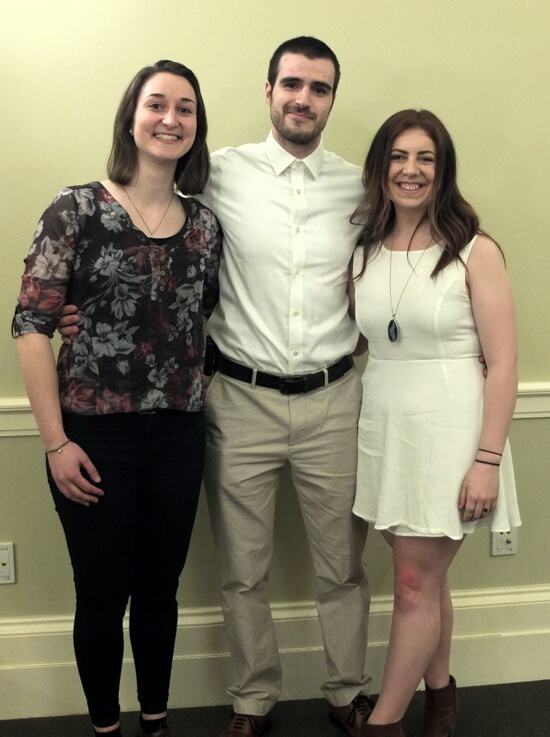
(from left) Lea Kirch is the 2019 SIFT participant, Miguel Vaccaro is the 2019 S-IMEW participant, and Ashton Baich is the 2019 Logan Prize winner.
In one instant, all participating members of the ESSA and Fletcher Club executives coalesced!:
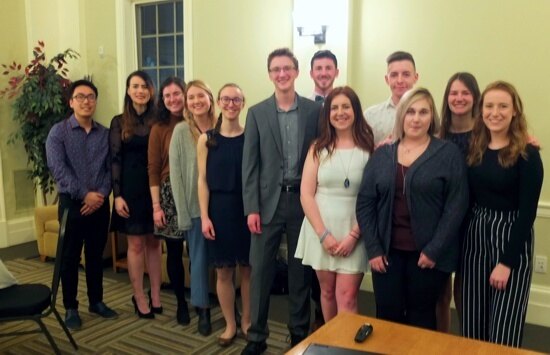
From left: Travis Le, Sarah Stewart, Megan MacIsaac, Victoria Taylor, Philicity Byers, Geoffrey Sharp, Alex Whitney, Ashton Baich, Tristan Townsend, Abbi McFee, Sarah Mitchell, Laura Moreau.
Northeast Geological Society of America meeting
24 March 2019
Sandra Barr joined more than 800 other participants at the annual meeting of the Northeastern Section of the Geological Society of America (NEGSA) in Portland, Maine, March 16th-19th, 2019. The NEGSA is a diverse meeting that provides excellent opportunities for building collaborations with geoscientists and potential graduate students in New England, whose research interests tend to be connected by geographic proximity and geological similarity to Nova Scotia. Sandra gave two oral presentations, the first in a special session on "The Roles of Geochronology and Geochemistry of Granitoid Plutons in Deciphering Orogenic Events", a session which she co-convened with Dr. David Gibson, University of Maine at Farmington. Her talk on "Deciphering tectonomagmatic events in the Ganderian Aspy terrane of Cape Breton Island, Nova Scotia, Canada: juxtaposed early Ediacaran through Devonian arc and within-plate plutons" was co-authored with Acadia MSc students Alicia Moning and Gabriel Sombini dos Santos and Acadia adjunct professors Deanne van Rooyen (Cape Breton University) and Chris White (NS Department of Energy and Mines). Her second oral presentation on "Contrasting Avalonian and Ganderian crust using Lu–Hf-isotopic composition and model ages of Neoproterozoic magmatic zircon grains" was co-authored by Jeff Pollock (Mount Royal University, Calgary), as well as Deanne van Rooyen and Chris White.
Sandra also presented a poster on "New U-Pb zircon ages from the Caledonian Highlands, southern New Brunswick, Canada: implications for magmatic evolution in Avalonia", a collaboration with Susan Johnson and Adrian Park (NB Department of Energy and Resource Development), Greg Dunning (Memorial University), Deanne van Rooyen, and Chris White. In addition, she was a co-author on six other abstracts presented at the conference, a "career high" for presentations at a single conference.
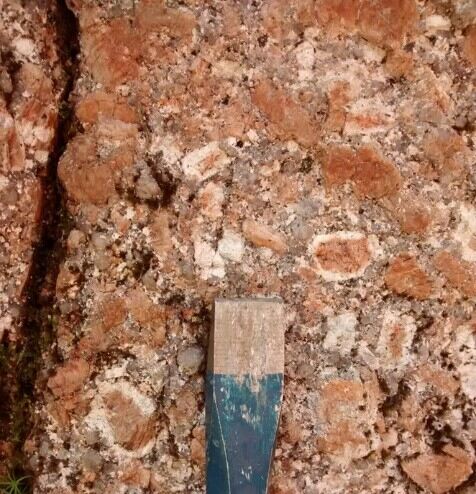
The 363 million-year-old Margaree granite, one of the plutons in the Aspy terrane of Cape Breton Island.
Science Atlantic Environment Conference 2019
11 March 2019
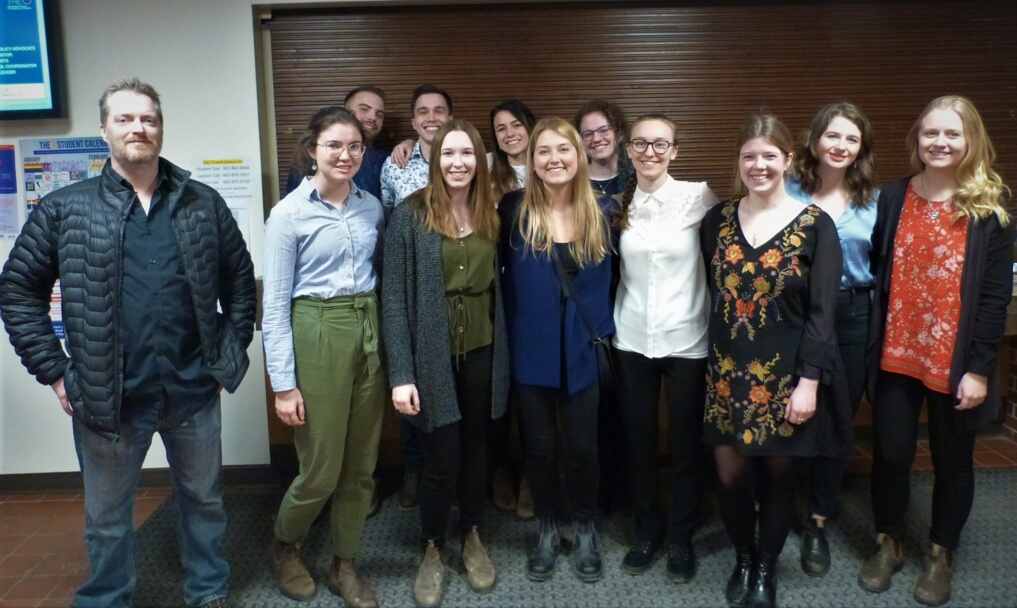
Group Photo (left to right): Front- Dr. O’Driscoll, Megan MacIsaac, Brianna Bowes, Victoria Taylor, Philicity Byers, Hannah Machat, Anna Murphy, Rebecca Dodge. Back – Jake Reicker, Tyler d’Entremont, Sarah Stewart, Rachel Clarke. Missing from photo- Sarah Adams.
Nine undergraduate and three graduate students attended the Science Atlantic Environment Conference (SAEC) this past weekend at St Francis Xavier University in Antigonish, Nova Scotia (March 8-10) with Dr. O’Driscoll. Sara Stewart won the 2nd place undergraduate presentation award and Sara Adams the 2nd place graduate presentation award. Students experienced great talks by their peers, several events related to the proposed boat harbour remediation (lecture, field trip, and a panel discussion), and enjoyed a banquet with the invited speaker (Jacquelyn Stevens) overviewing her career path from geology to environmental law. We are extremely proud of this great group of student researchers.
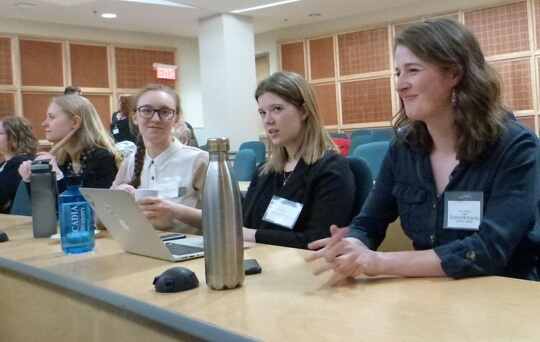
Becky Dodge, Philicity Byers, Hannah Machate and Anna Murphy contemplating in one of the sessions.
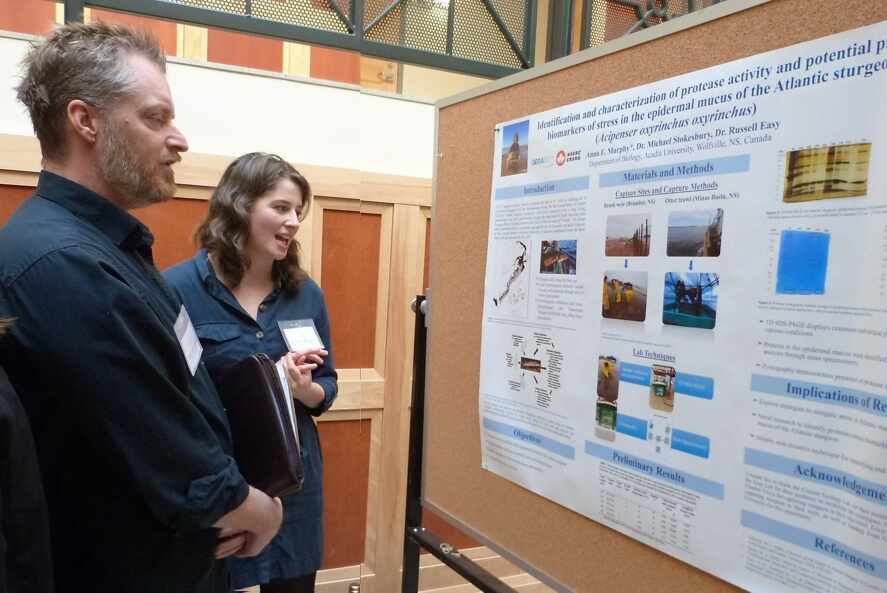
Anna Murphy giving a presentation on her thesis poster to Nelson O'Driscoll.
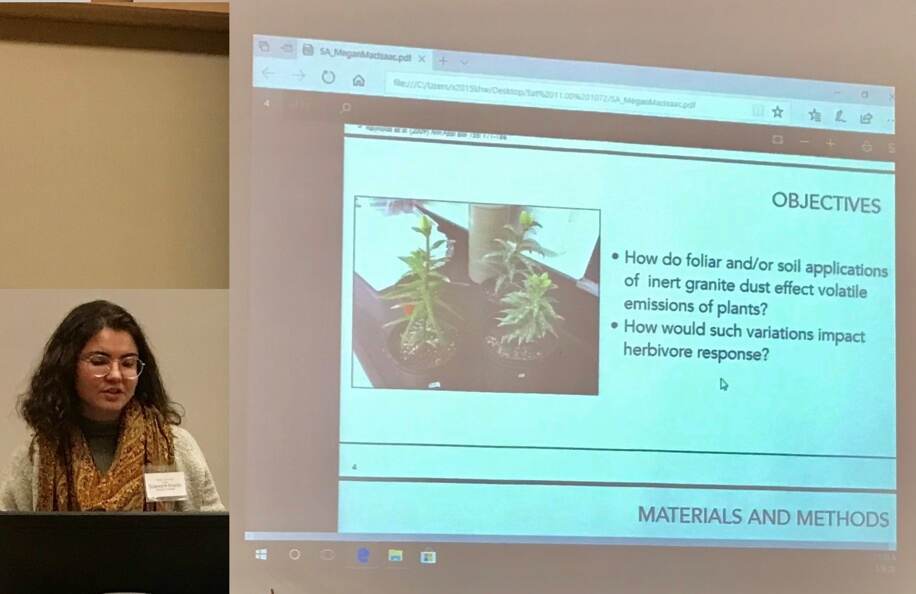
Megan MacIsaac discussing the use of granite dust to control lily beetles.
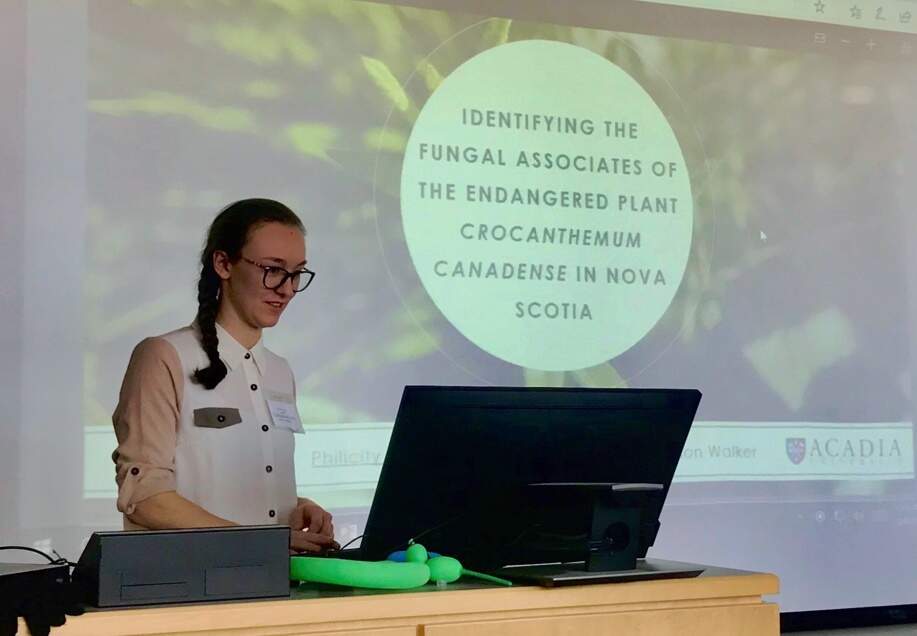
Philicity Byers presenting her findings on Crocanthemum canadense
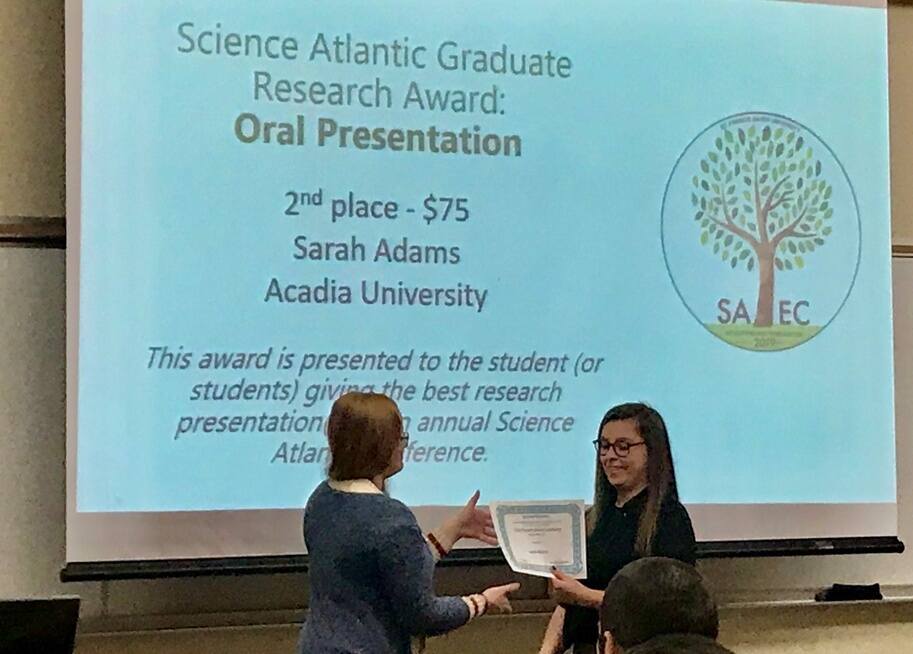
Sarah Adams receiving recognition for her oral presentation in the graduate student category.
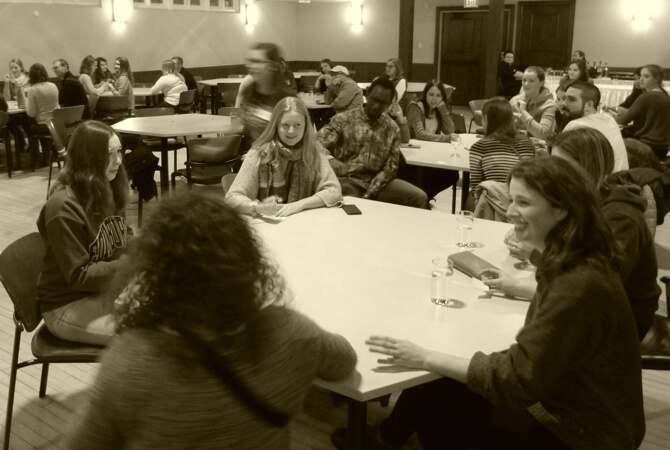
The Acadia group in one of the break-out sessions
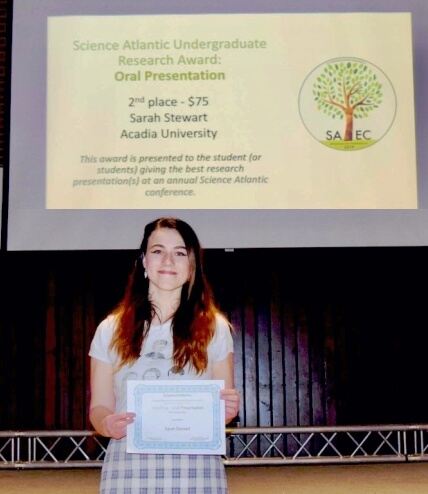
Sarah Stewart looking happy with her Oral Presentation award.
Acadia alumna discovered Dimetrodon prints in PEI
28 February 2019
Laura McNeil, an MSc graduate in Geology, has been credited with the discovery of a set of tracks of the dimetrodon Bathygnathus borealis in Prince Edward Island National Park. These tracks represent one of only about five fossils of a dimetrodon known from the Permian rocks of PEI.
Josh Caines (BSc '13) at work in the North Sea
14 February 2019
Josh Caines updated us on his exploits with the Newfoundland-based company PanGeo Subsea as he works out of Amsterdam in the North Sea. After graduating from Acadia with a BScH in Geology in 2013, Josh attended the Centre of Geographic Sciences and acquired an Advanced Diploma in Marine Geomatics. Following graduation, he moved to Texas to pursue a career as a geophysical technician with Dawson Geophysical. The position involved survey design and data processing of seismic projects for oil and gas exploration. He worked with this company for three years and traveled throughout the US and Canada. One unique assignment took him to Oak Island, Nova Scotia, to do survey work for a TV program from the History Channel, “The Curse of Oak Island”. The work involved designing and surveying a seismic program in search of the tunnels that are thought to hold lost treasure.
In the summer of 2018 Josh returned to Canada to accept a position as Offshore Geoscientist for Pangeo Subsea Ltd. of Newfoundland, working in the field of marine construction. His current position requires him to travel to Europe regularly and work offshore on ROV equipped survey vessels. The position involves subsurface feature detection using shallow acoustic systems. The work involves interpretion of 3D seismic data, including detection of unexploded World War two era ordinance to allow for safe dredging operations and the installation of subsea cables.
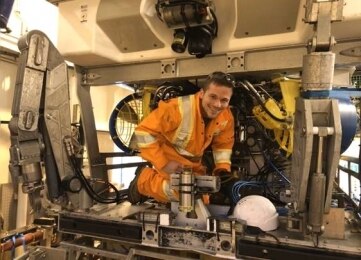
The work is done using a remotely operated vehicle (ROV), which obviously requires Josh to maintain it.
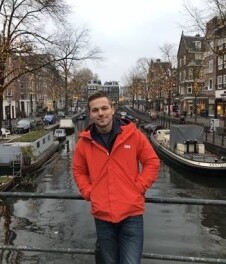
In his off-time, he enjoys travelling in Europe or spending time in Vancouver where he kayaks in the summer and downhill skis in the winter.
AGS Colloquium 2019 in Fredericton
14 February 2019
The 45th Colloquium and Annual General Meeting of the Atlantic Geoscience Society were held at the Fredericton Inn, Fredericton, New Brunswick, on February 8 to 9, 2019. Nearly 200 participants enjoyed a full and diverse program pushing the boundaries of geoscience in all its branches. As usual, the event was well attended by industry, government and university participants, including 3 professors, 18 students and at least twice that many former students from Acadia University.
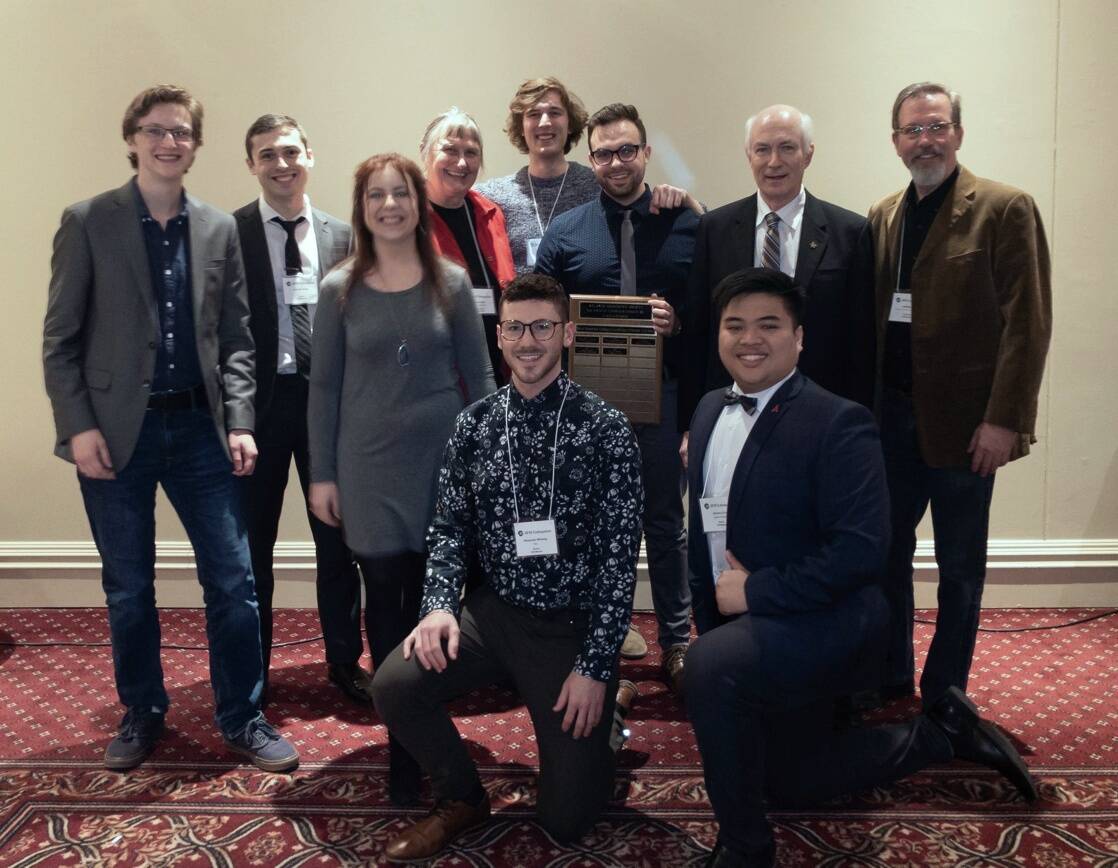
Acadia students and professors at the closing banquet and awards event (photo: Anthony Chu).
This year’s Colloquium started on Friday morning with two well-attended, half-day workshops: (1) Structural Controls on Gold Deposits by Stefan Kruse of Terrane Geoscience Inc and (2) Creating beautiful, effective, and reproducible graphics for geoscience using R', organized by Dewey Dunnington, former MSc Geology and BSc Environmental Science student at Acadia, now pursuing a PhD at Dalhousie. Poster displays started late Friday afternoon and remained available to view until late Saturday afternoon.
Three concurrent sessions ran Friday evening: (1) a special session in memory of Trevor MacHattie focussing on mapping, petrology, geochemistry and mineral deposits; (2) Minerals, metals and fluids associated with granitoid rocks; and (3) Current research in Carboniferous geology in the Atlantic Provinces. Meanwhile, a very busy poster session was set up with 26 posters on display.
Saturday’s events started early with concurrent sessions involving a special session in memory of Ron Pickerill on Paleontology and sedimentology in Atlantic Canada, and sessions on Geohazards recent and historical, Earth Science outreach in the Atlantic Provinces, and general sessions on current research in the Atlantic Provinces.
Special note is made of Acadia student Garrett Velkjar, who gave an oral presentation on "A 100-year paleolimnological record of environmental change from Cecil Lake, northern British Columbia" and to Garrett Hooey who presented a poster "Investigating volcanogenic massive sulphide and vein mineralization and its host rocks in drill core from the Jumping Brook Metamorphic Suite, Faribault Brook area, Cape Breton Highlands, Nova Scotia" and Dylan Wyles who presented a poster on "Applied paleolimnological assessment of anthropogenic impact in a back-barrier lagoon, Pictou Landing, Nova Scotia."
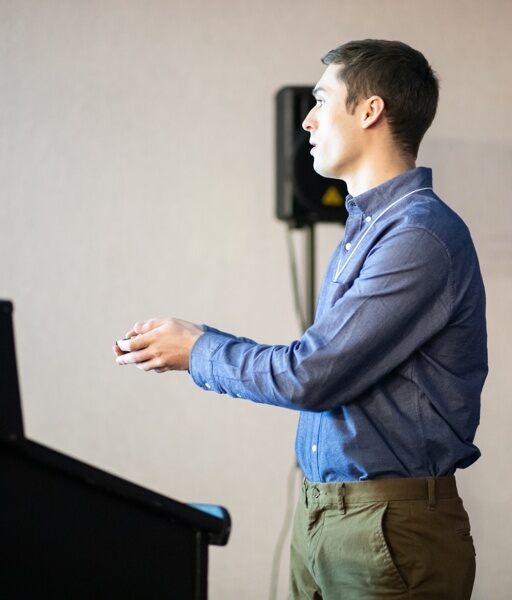
Garrett Velkjar presenting his research findings (photo: Anthony Chu)
Saturday evening was the Awards Banquet and Social where following dinner several prestigious AGS awards were presented in recognition of worthy student presentations and professional accomplishments.
Student award winners were:
Rob Raeside best undergraduate poster award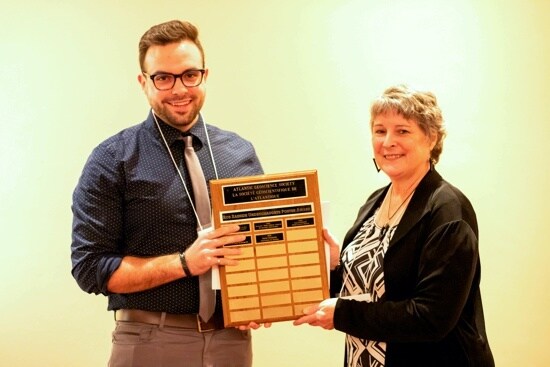
Dylan Wyles (Acadia University) receiving the award from AGS President Martha Grantham (photo: Anthony Chu)
Rupert MacNeill best undergraduate paper presentation
The award was given to Liam McNeil (UNB), and was received by a bevy of UNB professors - Bruce Broster, Jennifer Day, Dave Lentz and Karl Butler (photo: Anthony Chu).
Graham Williams best graduate student poster award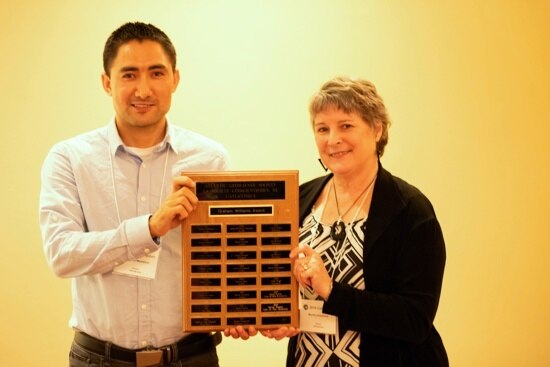
Mehmut Memtimin (St. Mary's University) receiving the award from AGS President Martha Grantham. An honourable mention was also made for the poster presented by Johana Gomez Gomez (UNB) (photo: Anthony Chu)
Sandra Barr best graduate student oral presentation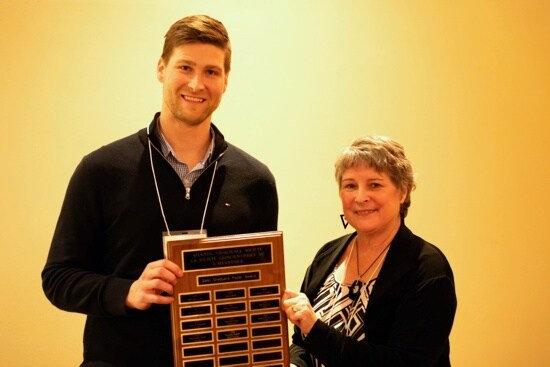
Mitch Kerr (St. Mary's University) receiving the award from AGS President Martha Grantham. An honourable mention was also made for the paper presented by Matt Stimson (St. Mary's) (photo: Anthony Chu)
Finally, three awards were made to AGS members to recognise their distinguished service to Earth Science and the Society. The Nelly Koziel Award was made to Tracy Webb, current chair of the AGS Education Committee and Acadia geology graduate, 1982.
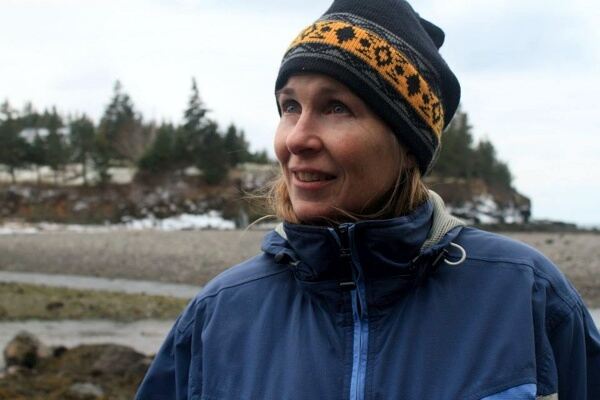
Tracy has recently retired from high school teaching at Horton High School, Nova Scotia, and is about to depart for 4 months Education intern supervision in China, so was unable to be present to receive the award.
The Laing Ferguson Distinguished Service Award was made to Elisabeth Kosters in recognition of her many volunteer activities, including president of the Society (2012), board member of the Joggins Fossil Centre, executive director of CFES, and prominent activist for all things geological.
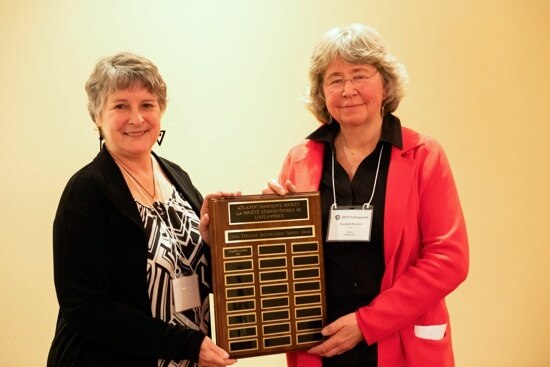
Elisabeth Kosters receiving the Laing Ferguson plaque from president Martha Grantham (photo: Anthony Chu)
The Gesner Medal and award for Distinguished Scientist was made to R. Damian Nance, in recognition of his many years of research in Atlantic Canada, including several terms at St. Francis Xavier University. Damian was on leave in Australia, so was unable to be present, but he sent an entertaining acceptance speech which was read by Sandra Barr, seconder of his nomination by Brendan Murphy for the award.

Reginald Moore Memorial Award in Geoscience
13 February 2019
A new award, the Reginald Moore Memorial Award in Geoscience has been established in the Department of Earth and Environmental Science at Acadia. Made possible by Dr. Peter von Bitter, Senior Curator Emeritus of Natural History at the Royal Ontario Museum, Dr. Reg Moore was pivotal to his development at Acadia. Peter writes that "what I learned from him, both as a teacher and as a human being, has been valued by me and has stood me in very good stead throughout my life and career as a geologist and paleontologist. I might also add that the Acadia Geology Department did a fine job of preparing my generation of students, and most importantly gave us the confidence to go out and understand and deal with our geological world."
Members of the department are very grateful to the generosity of Dr. von Bitter for establishing this award, which will allow us to recognize and help students who emulate some of Dr. Moore’s core academic values, namely engagement in geoscience and the demonstration of the promise of continuing development. Dr. Moore was as interested in where students were going as where they were at, so the award will recognize promise, aptitude and emerging talent.
Environmental Science accreditation renewed
23 January 2019
The Acadia University Environmental Science programs were successfully re-accredited through the Canadian Environmental Accreditation Commission. Both the Honours and the BSc program were accredited following the review undertaken in April 2018. The accreditation provides recognition of the mission and objectives, institutional and program requirements, program development and maintenance, curriculum, faculty complement, admissions, student services, institution facilities and learning resources, financial resources, and scholarly activity. The accreditation is valid until July 2025.

Guest speaker, Maisa Abram
22 January 2019
The department has been pleased to host Maisa Abram for the past few months as she works on her PhD thesis with the assistance of Dr. Peir Pufahl. In return, she gave us a presentation on the geology of Brazil and her work on phosphate deposits in the Parnaiba Basin, northeast Brazil. Maisa works with the Geological Survey of Brazil in Salvador, BA.
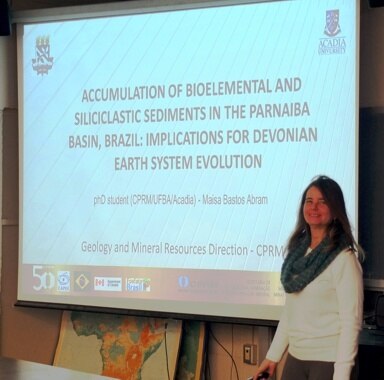
Kirk Woodman
20 January 2019
The Department of Earth and Environmental Science, in which Kirk Woodman (B.Sc, Acadia, 1985) was an undergraduate student from 1981-1985, is deeply saddened by his death while working in Burkina Faso. Our thoughts are with his family, friends and colleagues.
Kirk worked for Progress Minerals, based in Vancouver, but lived in the Halifax area. He was abducted and subsequently shot by the abductors from the mining site in the north of the country. He had worked in Burkina Faso and neighbouring Niger for many years. Several years ago he was the banquet speaker at the end-of-year dinner, when he told of his experiences in Niger, illustrated with beautiful images of that semi-desert region.
Kirk's obituary can be seen at https://www.arbormemorial.ca/atlantic-sackville/obituaries/kirk-woodman-kenneth-kirkland/29375/

